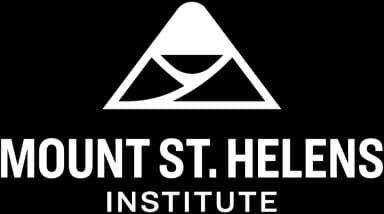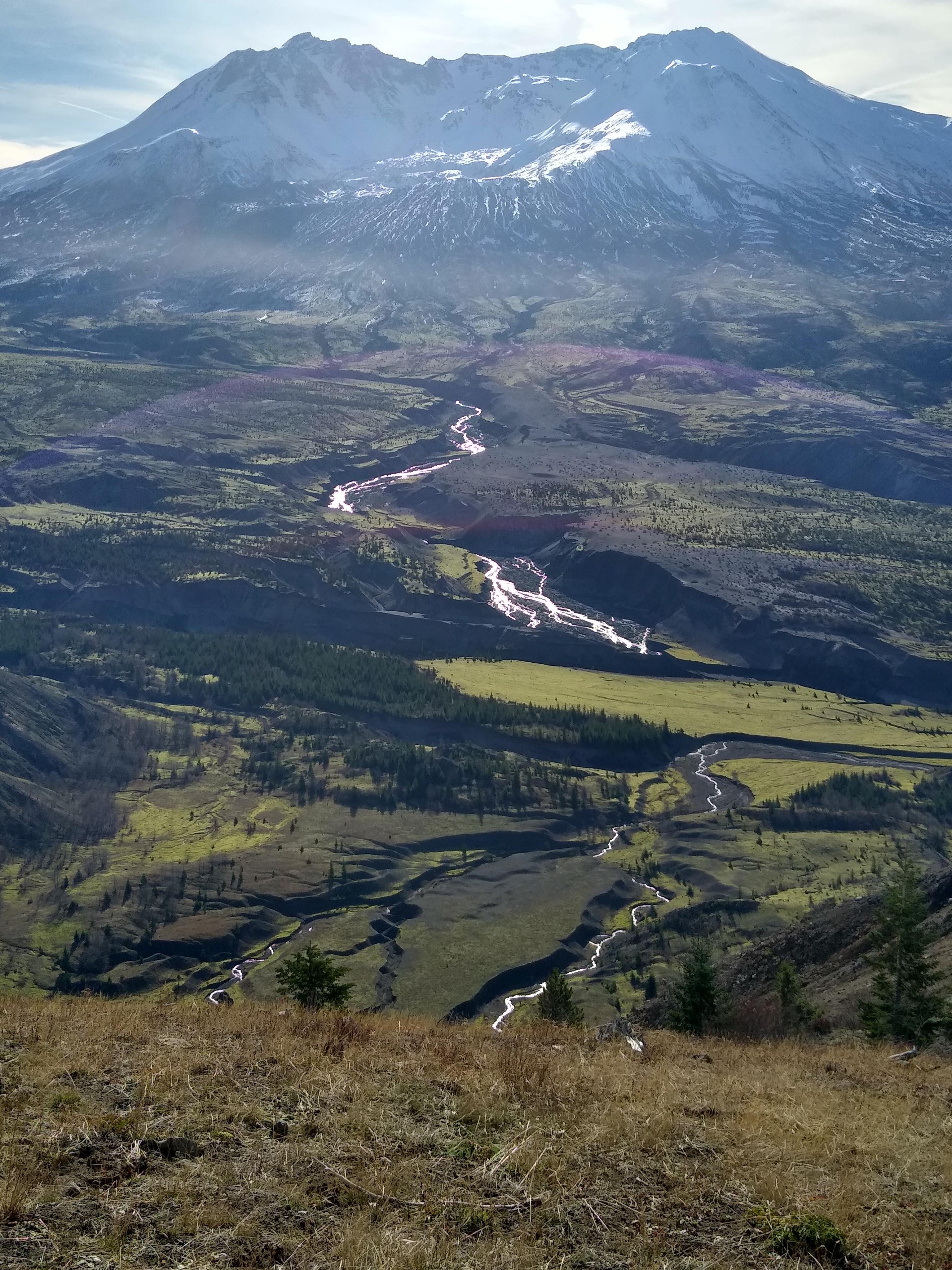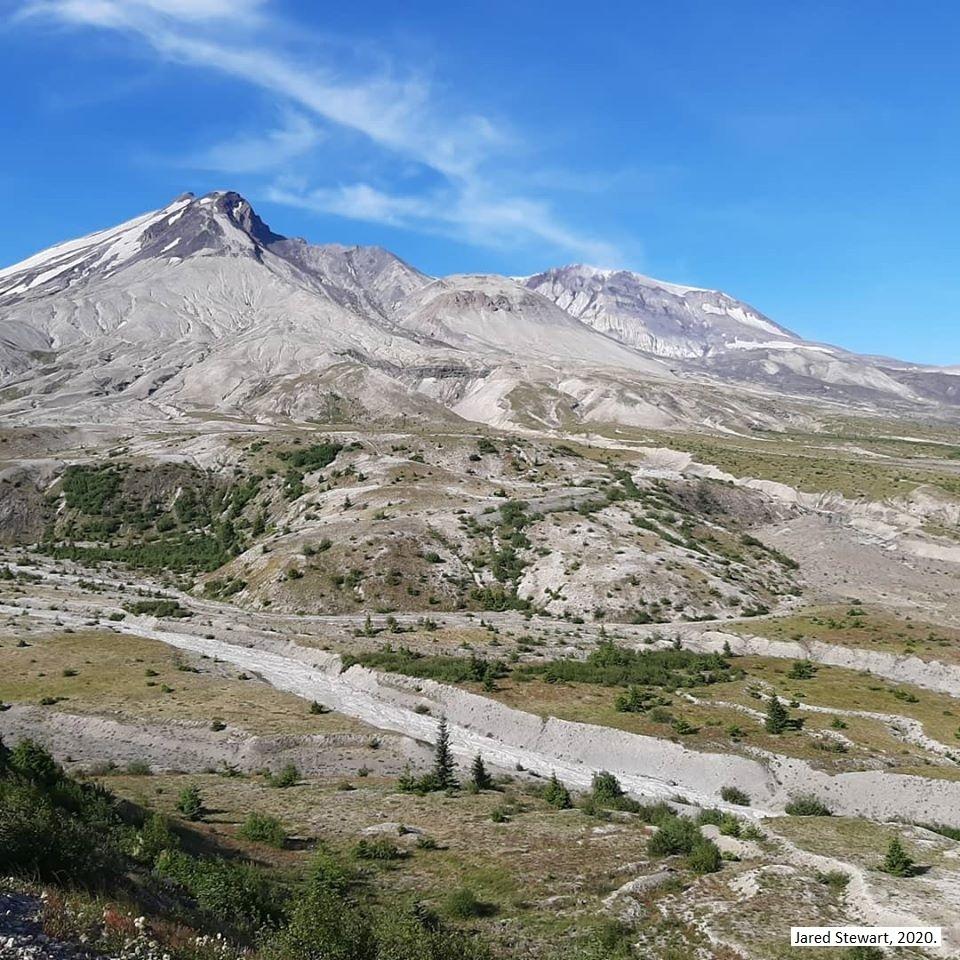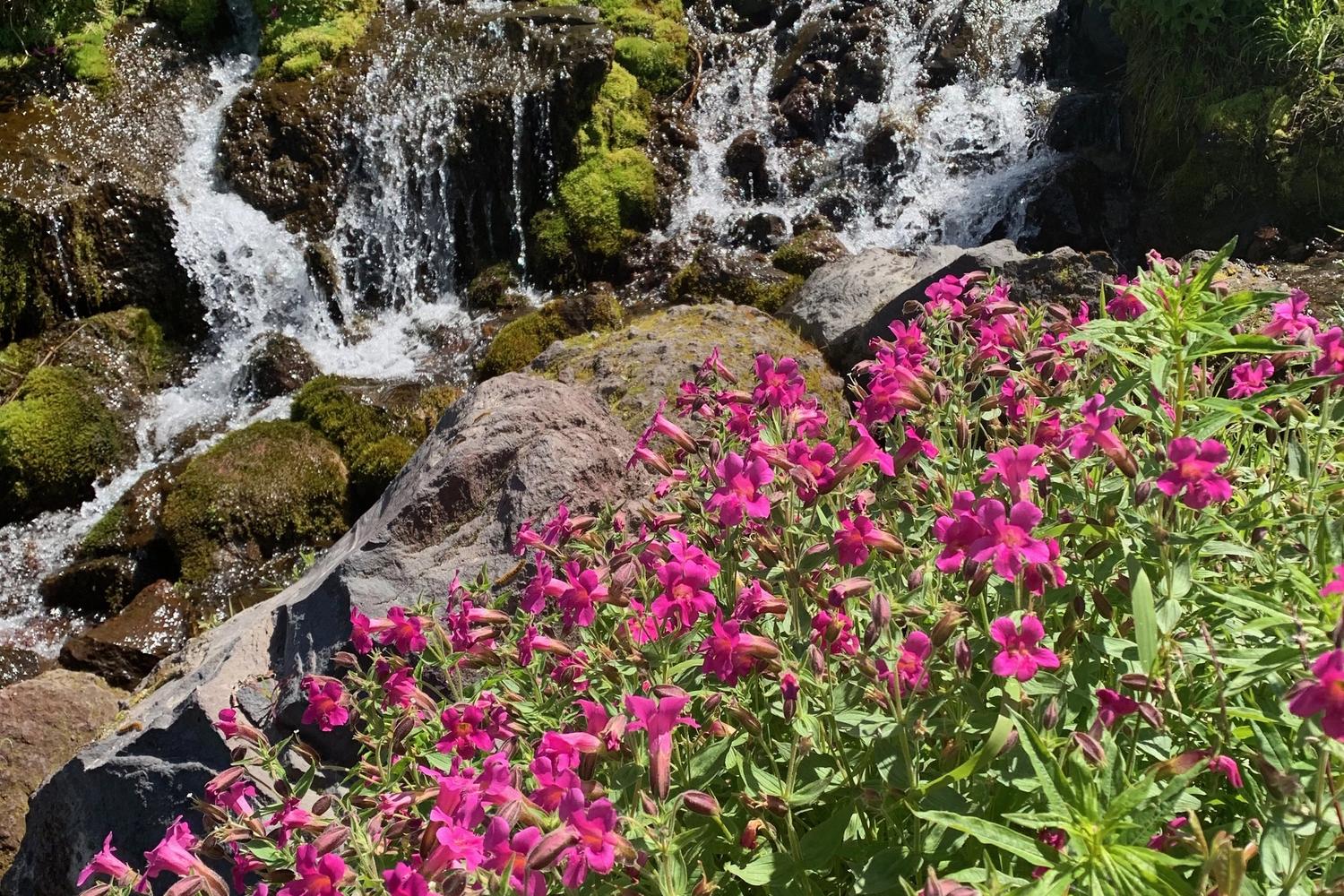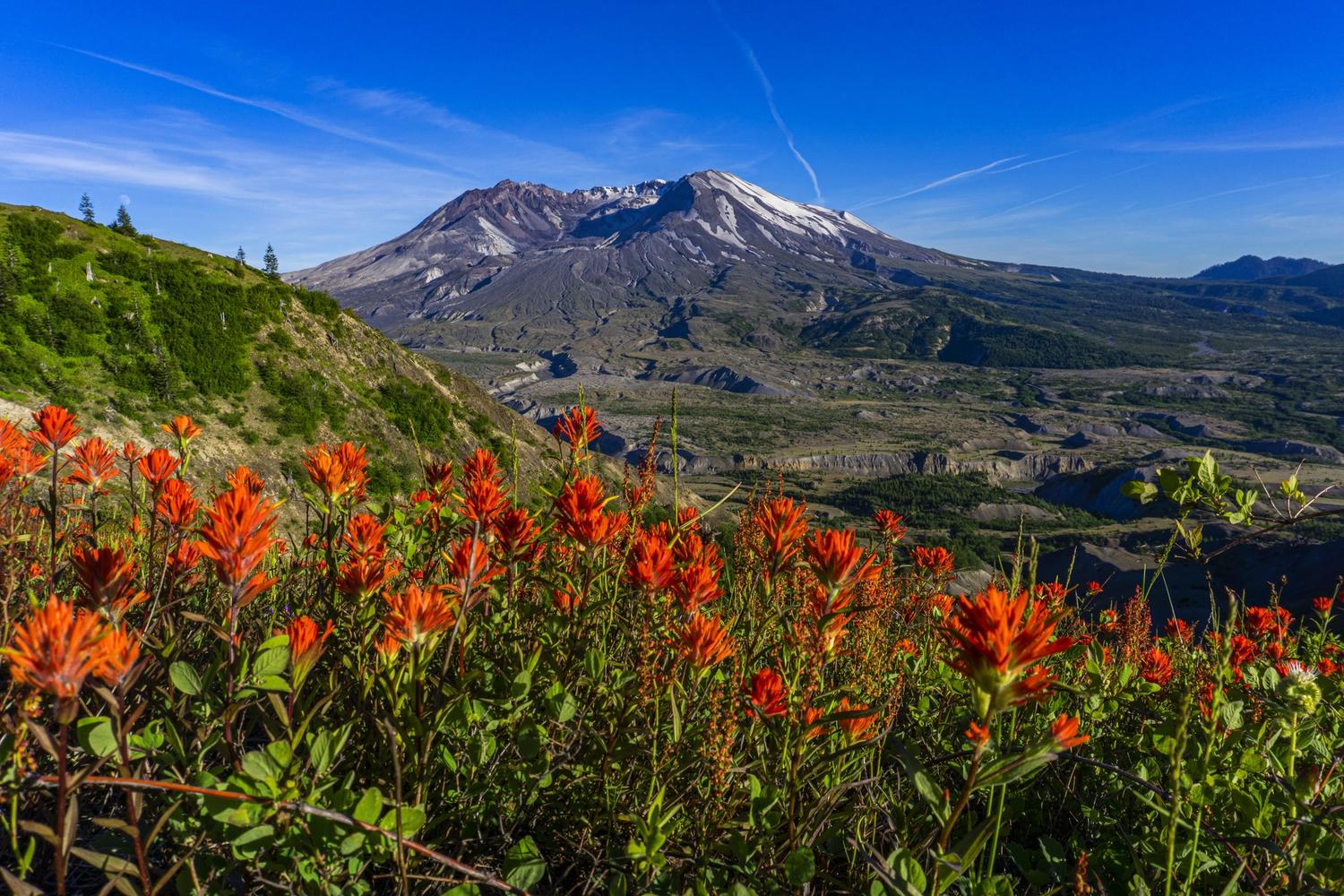We use cookies to improve your website experience. Essential cookies are required for the site to function properly, while analytics cookies help us understand how visitors use our site to make improvements. You can choose to accept all cookies or only the essential ones.

Plan a Visit to Mount St. Helens
Visiting Mount St. Helens: Three distinct zones
Mount St. Helens has three main access points: the north side, via Highway 504 from I-5; the south side, accessible multiple ways; and the east side, accessible via Randle, WA, and Highway 12 from the north only in 2025.
Many people will visit more than one zone in a multi-day trip, but it is difficult to visit more than one zone in one day. Travel time between zones ranges from 2-4 hours.
The Mount St. Helens National Volcanic Monument is managed by the US Forest Service. For current information about closures, hours, and conditions, visitors may contact the district's front desk at (360) 449-7800 during business hours.
Best of the Best...by season
Visiting Mount St. Helens at a specific time of year? Check out the best activities for the season!
Find a Trail
People love Mount St. Helens! Learn more about trails at Mount St. Helens from our partners at Washington Trails Association, the US Forest Service, and local affinity groups.
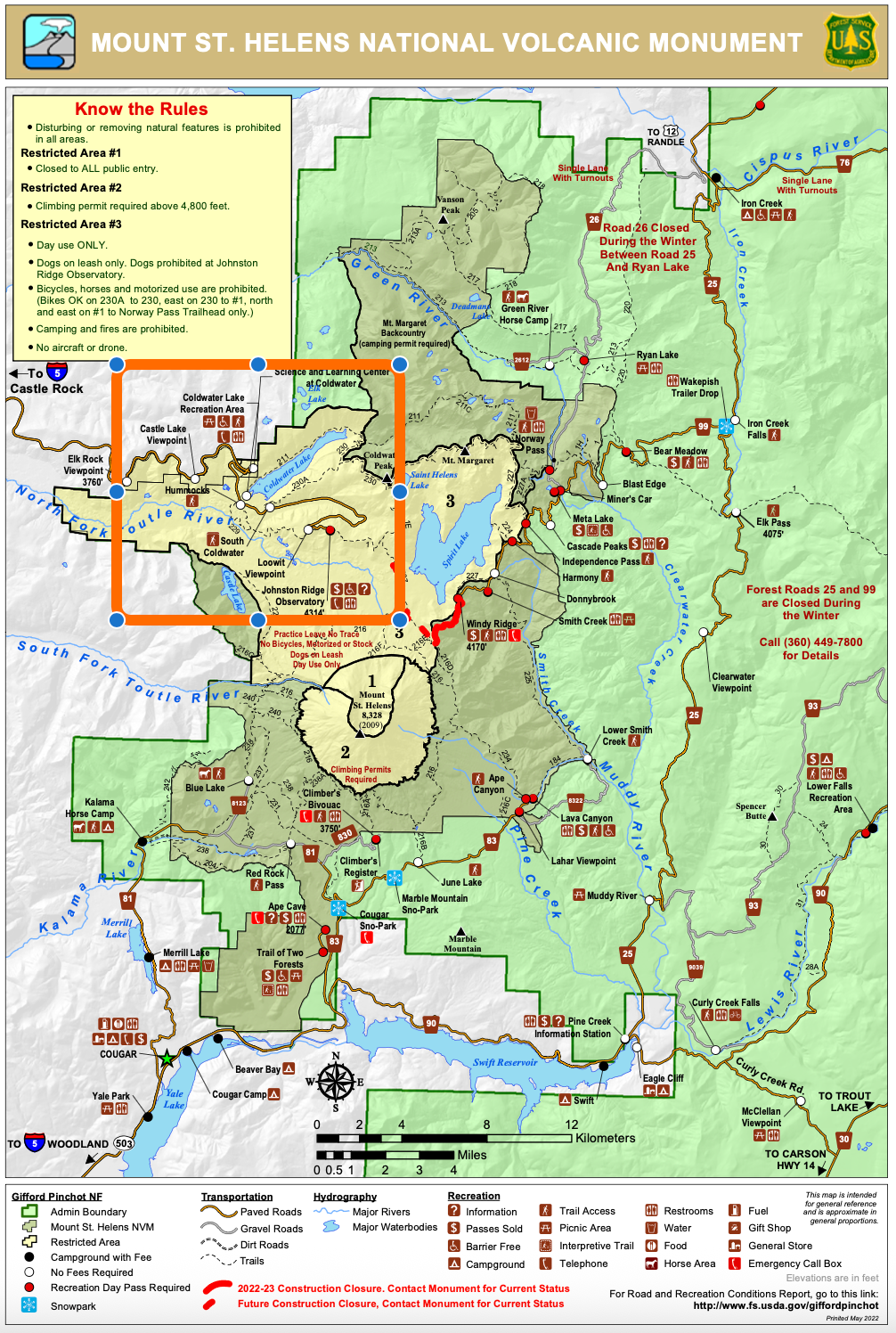
Northwest Side: Visitor Centers and Crater Views
Visit Mount St. Helens' northwest side (accessible from the west) for accessible visitor centers, gift shops, and sweeping views. Visit the sediment retention structure, see the Toutle River, Coldwater Lake, and hike the Hummocks Trail. Dogs are permitted on-leash on Monument trails.
The Highway 504 Corridor has multiple visitor centers. Johnston Ridge Observatory and the Science and Learning Center at Coldwater are inside the Mount St. Helens National Volcanic Monument and offer experiences closest to Mount St. Helens. There is no food service or gas past Drew's Grocery in Toutle. During the late fall, winter, and early spring, there are no public restrooms available past Toutle.
Mount St. Helens Institute Programs
North side programs include:
- Volcano Outdoor School youth field trips
- GeoGirls
- Guided Eruption Hike
- Community campouts including Family Adventure Camp, Base Camp, and the Sky and Star Party
- Field trips as part of the Volcano Naturalist Certification program
Mount St. Helens National Volcanic Monument Attractions
Attractions within the Monument on the north side have incredible views of the volcano and the Toutle River, which was dramatically affected by the 1980 eruption. Visit Coldwater Lake, which was created by the eruption! Attractions are listed from the closest to Mount St. Helens to the edge of the Monument.
Many Monument attractions require a fee:
$5/day use pass. Purchase at recreation.gov, on the recreation.gov app, via on-site pay station, or at participating retailers.
Northwest Forest Pass: $30 annually
America the Beautiful federal interagency pass: free-$80 annually
For more information on fees, where to purchase passes, and where passes are required, visit the USFS passes site.
Location | Fees | Hours/Season | Things to Do | |
|---|---|---|---|---|
Johnston Ridge Observatory (CLOSED), 52 miles from I-5. | N/A, Closed until 2027 | Typically mid-May through the end of October, 7 days per week 10 am to 4 pm. Johnston Ridge is currently closed due to a landslide that cut off road access. | Accessibility: None. Activities/Attractions (when open): Gift shop. Flush toilets. Indoor exhibits. Hiking. Interpretive signage. Photo opportunities. Short uphill walk from parking lot to views. | 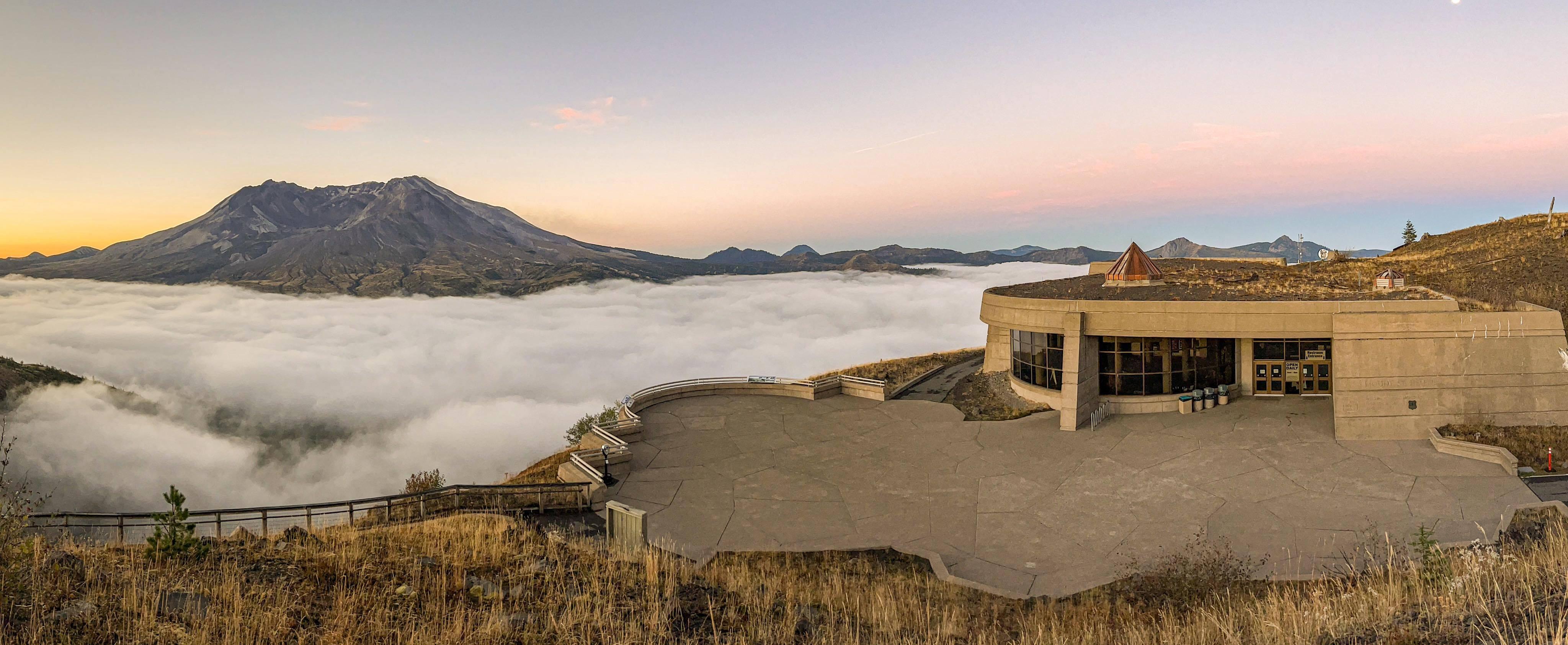 |
Walk in only (inaccessible by vehicle in 2025). Fees to park at Hummocks Trailhead or Coldwater Lake. Accepted passes: USFS Day use, Northwest Forest Pass, or America the Beautiful Interagency pass. | All hours. Road to trailhead not plowed in winter, access by foot only. | Accessibility: Trailhead is located behind gate on the road. Accessible by foot or bike. Do not pass barriers to continue up Highway 504 past the trailhead. Dogs permitted on leash. Activities/Attractions: Hiking. Mountain biking. Berry picking. Views of Mount St. Helens 1.5 miles uphill on the trail. Access to logging equipment destroyed by the eruption. | 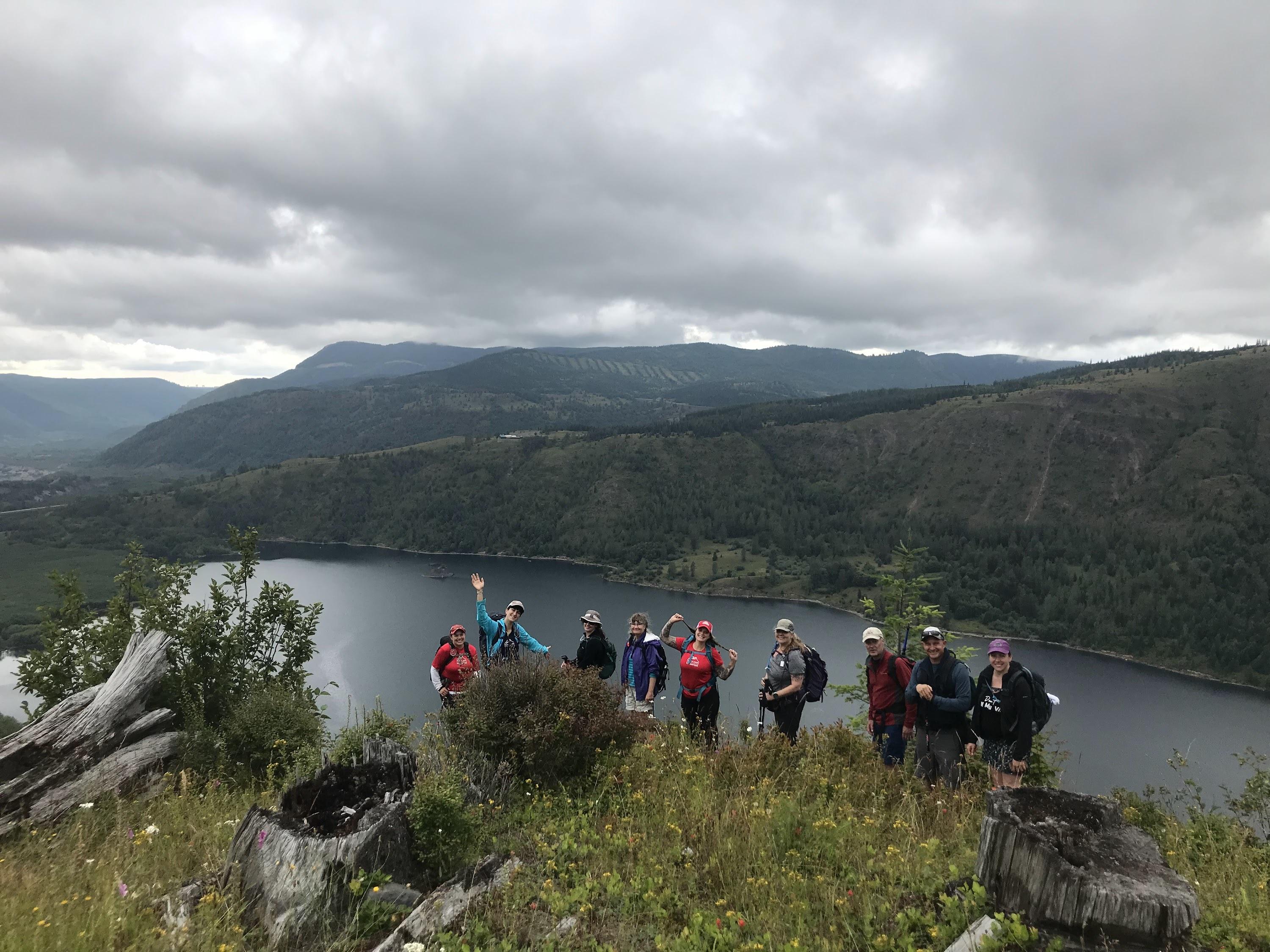 | |
Hummocks Trailhead 45 miles from I-5. | $5 Federal day use pass required, fee station at Coldwater Lake or the Science and Learning Center. Also accepted: Northwest Forest Pass, American the Beautiful Pass. | Open all hours. | Accessibility: Trail is uneven. Plenty of parking. Activities/Attractions: Hiking. Photo opportunities. No toilet. No views of the mountain from the parking lot. View requires a 1 mile round-trip walk. Access to Boundary Trail and Johnston Ridge Observatory (building closed). Download the Hummocks trail guide for a self-guided tour. Dogs are permitted on-leash. | 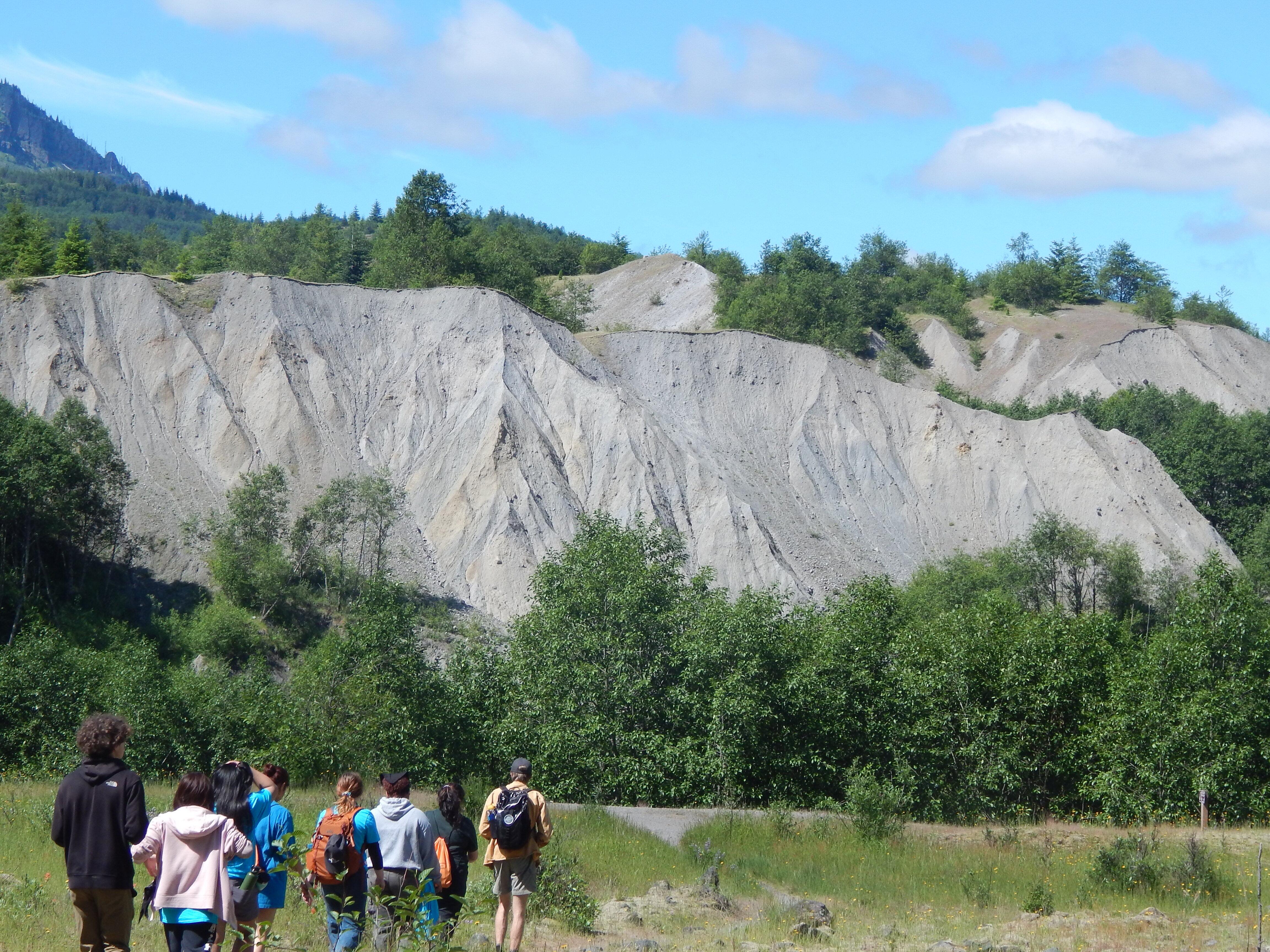 |
Coldwater Lake: Boat Launch and Day Use, 45 miles from I-5. | $5 Federal day use pass required, fee station on site. Annual Northwest Forest Pass or America the Beautiful pass also accepted | Day use only. Open year-round, winter months may require snowshoe access if road is not plowed. Check current conditions for more information. | Accessibility: Offers .6 mile accessible trail with interpretive signage. Two parking lots with accessible parking. Amenities/Attractions: Hiking. Accessible trail. Interpretive signage. Lake access for swimming, boating, and paddle sports (no gas motors). Picnic tables. Dogs permitted on leash. Portable toilets on the day use side; flush toilets may be available summer 2025. | 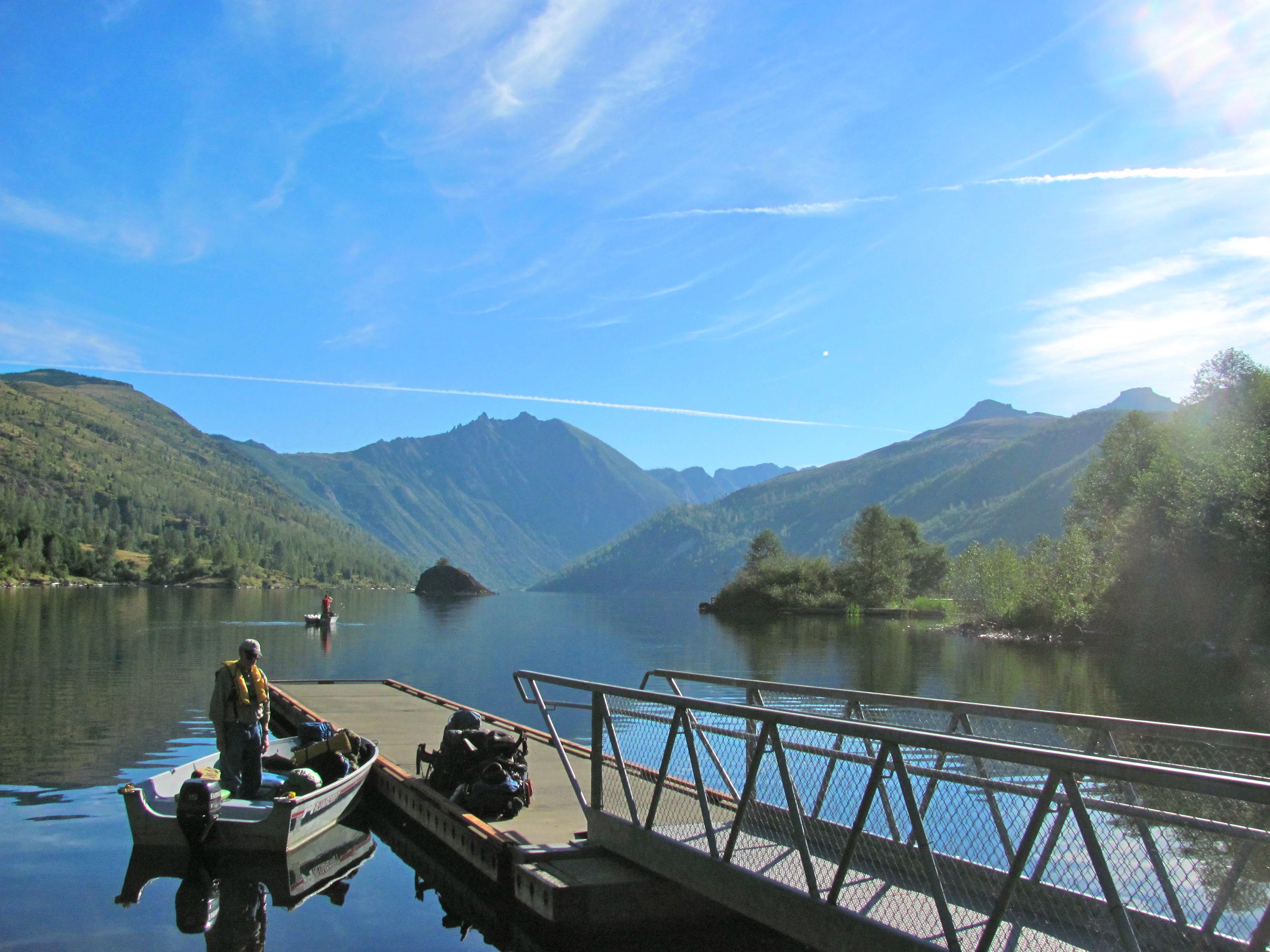 |
Science and Learning Center at Coldwater, 43 miles from I-5. | $5 day use fee. Passes available at onsite fee station. Annual Northwest Forest Pass or America the Beautiful pass also accepted. | 10 am to 4 pm when open. Schedules vary:
| Accessibility: Van accessible parking spots. Accessible toilets. Zero entry building. Wheelchair accessible 1/4 mile Winds of Change Trail. Activities/Attractions: Views from the parking lot and the Science and Learning Center. Elk Bench trail goes down the ridge to Coldwater Lake, the Lakes trail, and the Coldwater boat launch. 20 minute film. Educational exhibits. U.S. Forest Service Rangers on site during open hours. Dogs are permitted on-leash on the Winds of Change trail and in the parking lot. | 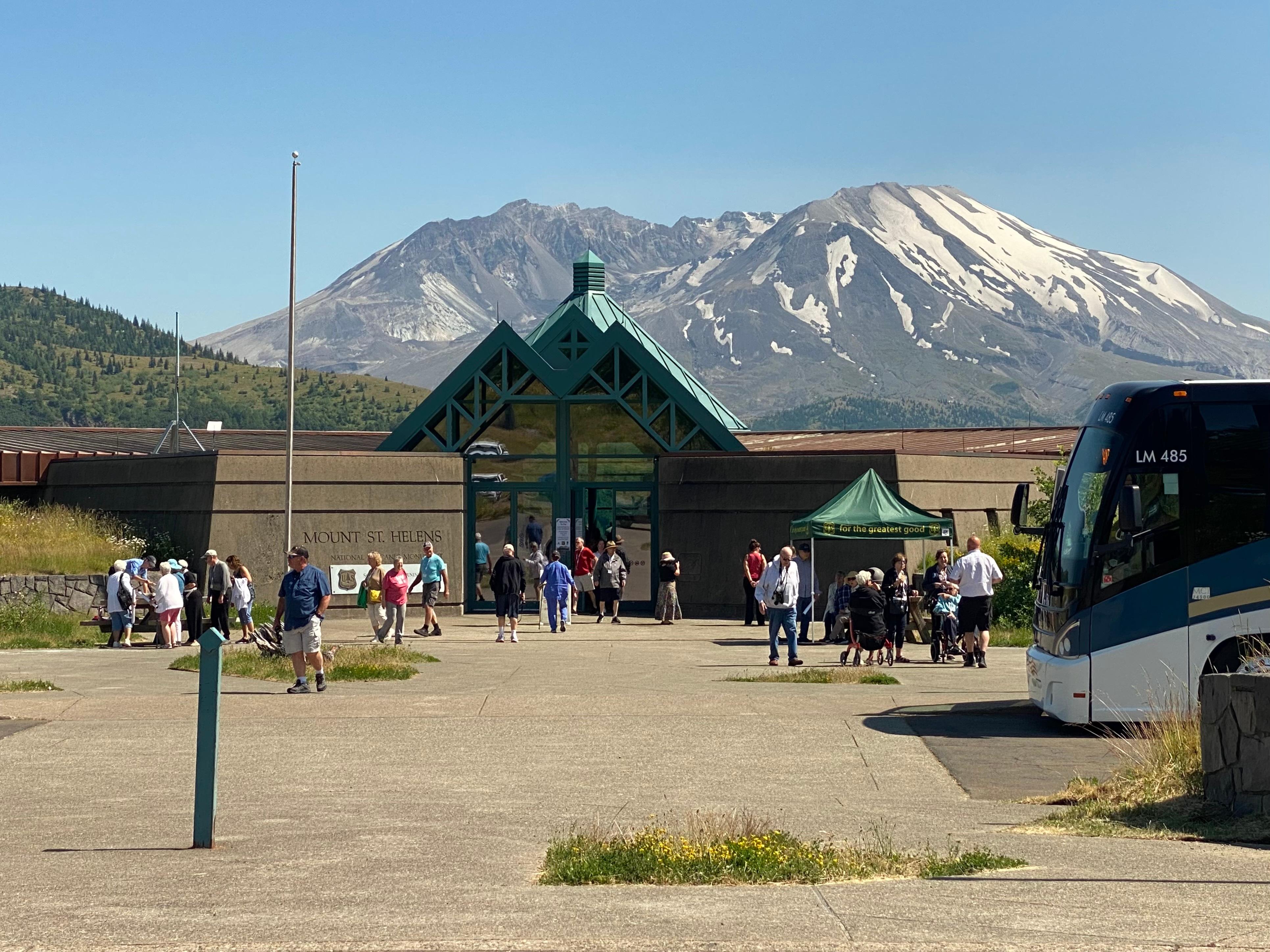 |
Castle Lake Viewpoint, 40 miles from I-5. | No fee. | Open year round. Access may be limited due to snow. | Accessibility: Ample parking. View from the parking lot. Activities/Attractions: View of Mount St. Helens (when it is clear). No restrooms. Closest restrooms are 10 minutes away at the Science and Learning Center. Dogs are permitted on-leash. |  |
Elk Rock Viewpoint, 37 miles from I-5. | No fee | Open year round. Access may be limited due to snow. | Accessibility: Ample parking. Raised sidewalk and short wall may partially obscure view from parking area. Activities/Attractions: View. No restrooms. Dogs are permitted on-leash. |  |
Attractions Along the 504 Corridor
From I-5 in Castle Rock as you approach the monument, there are lots of places to stop!
Location | Fees | Operating Hours | Accessibility |
|
|---|---|---|---|---|
Seaquest State Park and the Mount St. Helens Visitor Center, 5 miles from I-5 exit 49. These areas share a campus that is connected through a tunnel under Highway 504. | Seaquest: $10 Washington State Parks day use pass required for park access. Washington State Discover Pass provides annual access. Visitor Center: Ages 6 and younger: Free Ages 7 to 17: $2.50 Ages 18 and older: $5 Family: $15 (two adults plus accompanying children) Tour groups: $200 per bus | Seaquest: 8 am-dusk year-round Visitor Center: 9 am - 5 pm mid-May through the end of September. | Seaquest: Twelve miles of hiking trails. Biking. Camping. Overnight yurt stays. Playground. Flush toilets. Birdwatching. Visitor Center: Wheelchair accessible hiking. Interpretive signage. Flush toilets. Mountain views. Birdwatching. New exhibits in 2025! Boat access to Silver Lake is at the Washington Department of Fish and Wildlife boat launch. | 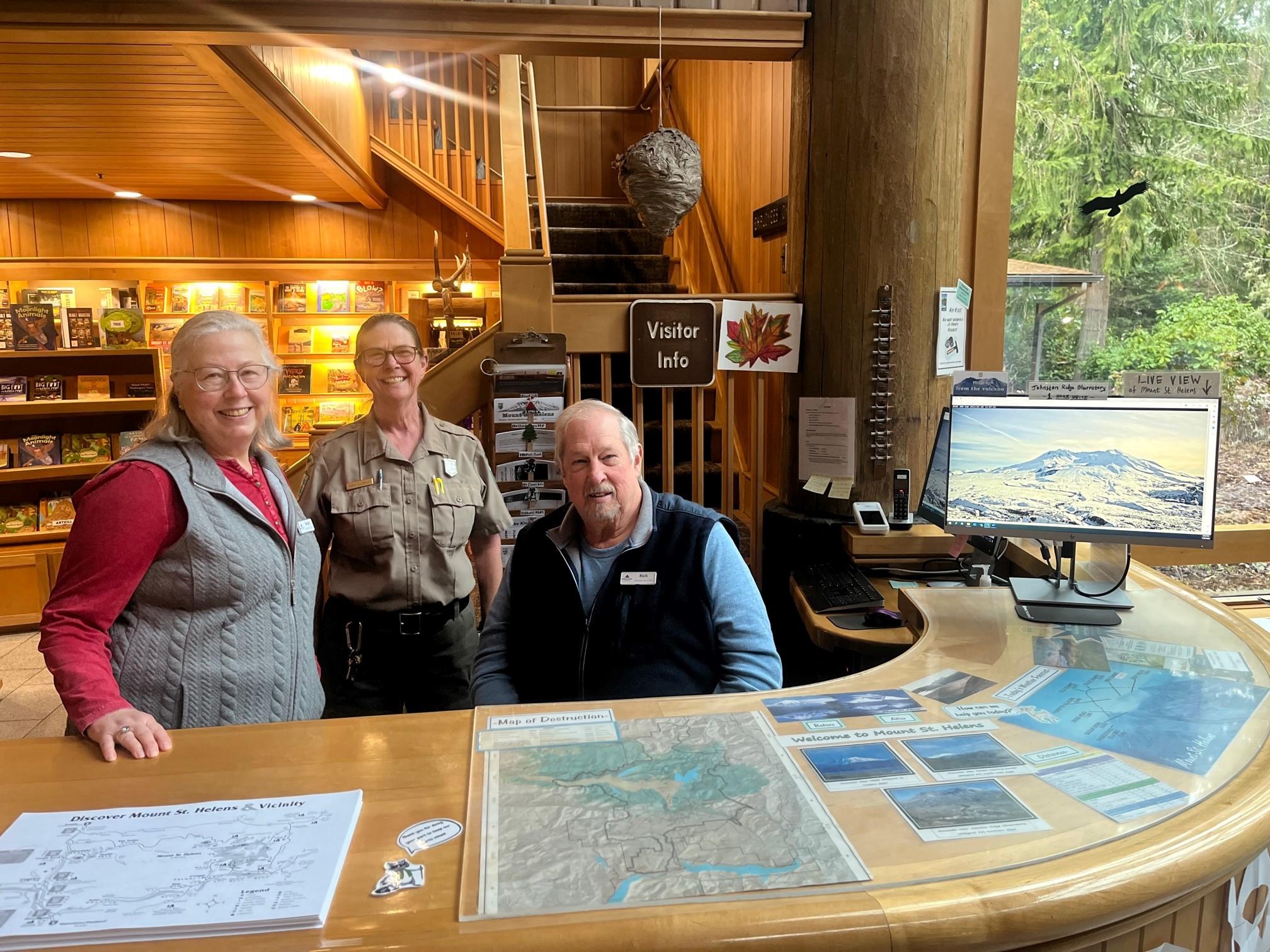 |
Town of Toutle, Washington, 10 miles from I-5 exit 49. | No fees. | Toutle offers recreation and services year-round. | Toutle is a small town that has gas, food, and recreation opportunities. | |
Sediment Retention Structure, 22 miles from I-5 exit 49 (northbound access) OR exit 63 (southbound access). | No fees. | Open year-round sunrise to sunset. | Accessibility: Not wheelchair friendly. Activities/Attractions: Vault toilets. Hiking. Interpretive signage. Point of interest. Managed by the U.S. Army Corps of Engineers. | 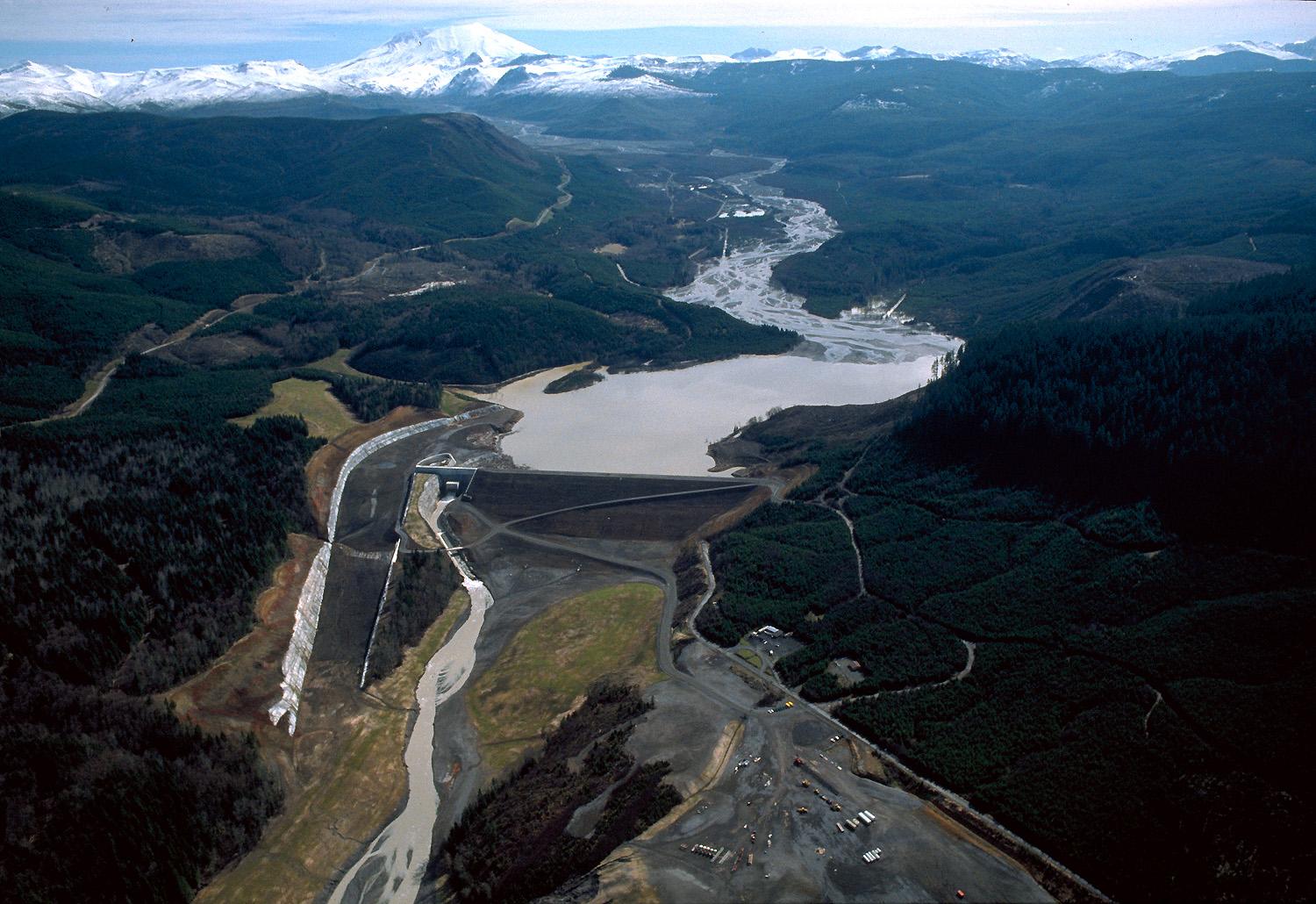 |
Weyerhaeuser Forest Learning Center, 33 miles from I-5 exit 49 (northbound access) OR exit 63 (southbound access). | No fees. | Open to the public every day from 10 a.m. to 4 p.m. May 17 through Sept. 28, 2025. | Accessibility: Building is wheelchair accessible. Wheelchairs available for use on-site. Activities/Attractions: Views of Mount St. Helens. Educational exhibits. Gift shop. Restrooms. Children's playground. |
Directions
From Seattle/Tacoma/Olympia, take exit 63 at Toledo (Highway 505). From Portland/Vancouver, take exit 49 at Castle Rock (Highway 504).

Where to Stay
The nearest accommodations to the Monument are found at EcoPark (rustic cabins, camping, and RV sites) and Kidd Valley Campground (tent and RV sites). Lodging and camping can also be found in Toutle, Silver Lake, Castle Rock, and Toledo as well as along the I-5 corridor.






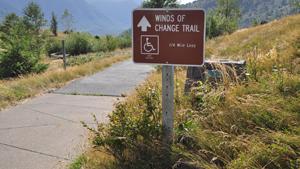

































South Side: Lava Tubes, Hikes, and Summit Climbs
Visit Mount St. Helens' south side to climb the volcano (permit required), explore Ape Cave, discover exposed canyons, and hike through the forest.
Visit Mount St. Helens' south side to climb the volcano (permit required), explore Ape Cave, discover exposed canyons, and hike through the forest.
Mount St. Helens Institute Programs
Mount St. Helens National Volcanic Monument Attractions
Attractions within the Monument on the south side have lots of variation. Lava tubes, tree casts, deep canyons, old growth forests, and the summit climbing route provide a wide variety of things to do and see.
Many Monument attractions require a fee:
$5/day use pass. Purchase at recreation.gov, on the recreation.gov app, via on-site pay station, or at participating retailers.
Northwest Forest Pass: $30 annually
America the Beautiful federal interagency pass: free to $80 annually
Location | Fees | Hours/Season | Things to Do | |
|---|---|---|---|---|
Two passes required:
| Open mid-May through the end of October 9 am to 5 pm. The cave is gated and closed Nov 1 through mid-May. Do not touch cave walls or ceiling. Touching kills cave slime, a basis for the food chain of tiny creatures that live there. Help protect our bats and caves from White Nose Syndrome. Practice Leave No Trace principles by packing out all that you bring with you. Bring at least two sources of light for hiking in the cave. Lanterns are available for rent at the gift shop. The cave is 42° F (5.5° C) year round, bring warm clothes. The cave ceiling drips water year round. Prepare to get wet and watch for puddles. The following are prohibited inside Ape Cave:
| Accessibility: Wheelchair accessible trail to cave entrance; cave is not wheelchair accessible. Floor of lower cave is rough; upper cave requires scrambling over boulders and a 6 foot wall climb. Activities/Attractions: Hiking in a cave! Gift shop. Vault toilets. Above ground hiking. Interpretive signage. Photo opportunities. No potable water. Short uphill walk from parking lot to cave entrance. No view of Mount St. Helens. Washington Trails Association hike description. | 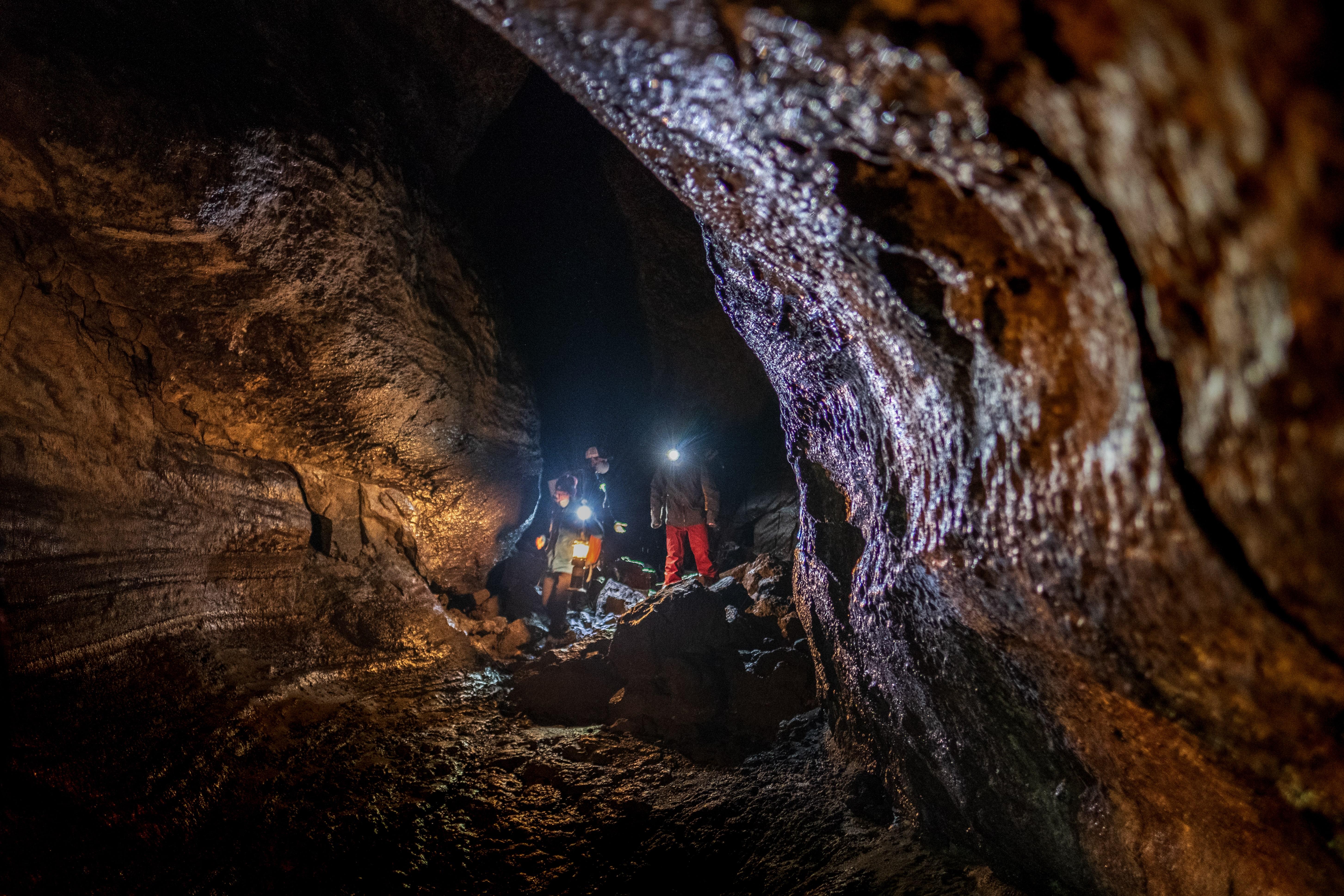 | |
Spring, summer, and fall: Day use or annual forest pass required. Winter: Washington State Sno-Park pass required December 1-March 31. Purchase online or through a vendor. | All hours. | Accessibility: Approach and 1/4 mile boardwalk are wheelchair accessible when snow-free. Activities/Attractions: Vault toilets. Points of interest are tree casts in a 2000 year old lava flow. Boardwalk. Interpretive signage. Dogs on leash permitted. | 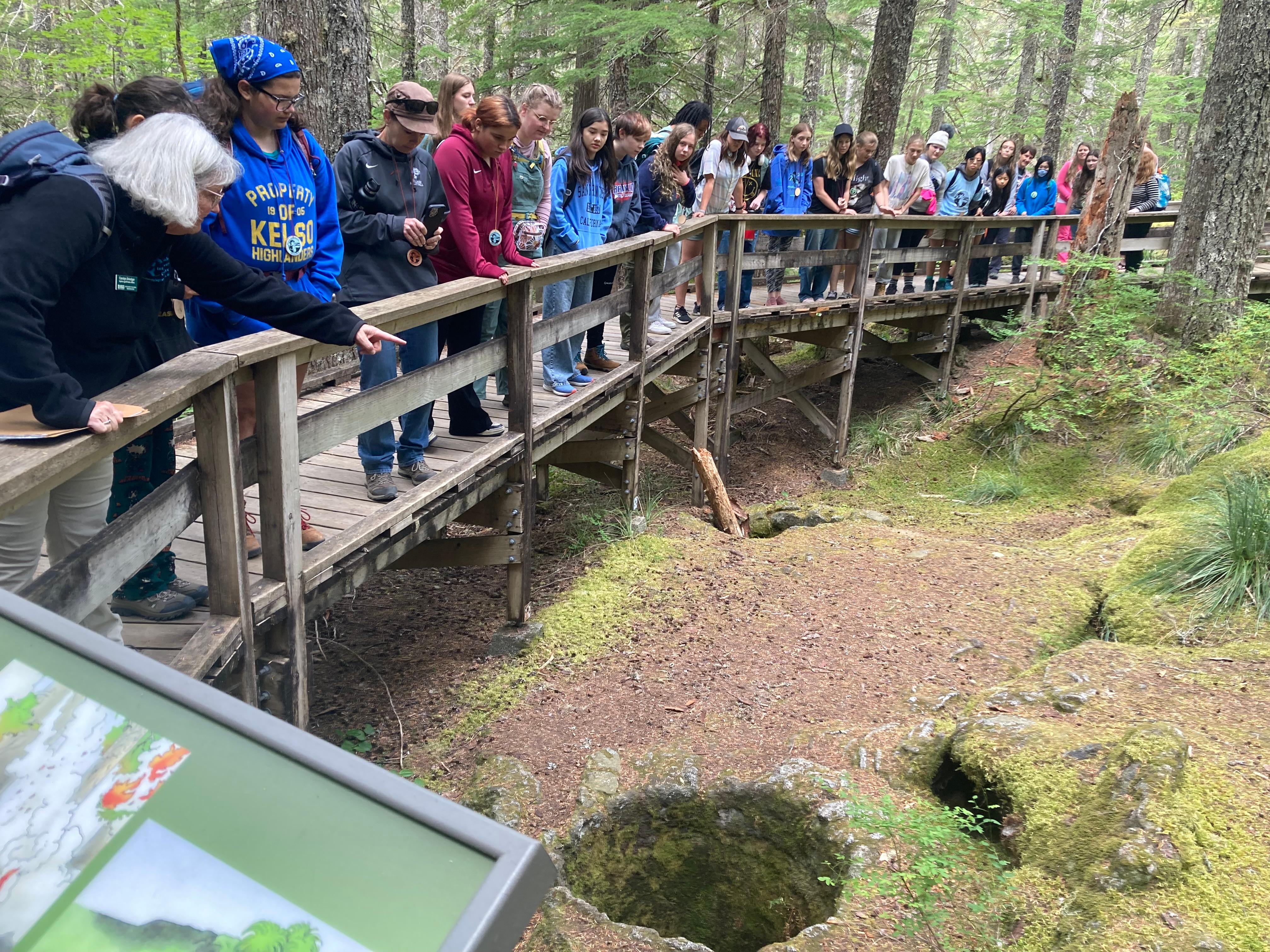 | |
No fee. | Spring, summer, and fall: All hours. Winter: Inaccessible by road. | Accessibility: No accommodations. No restrooms or water. High clearance vehicles recommended. Area is accessed by FR 81 to FR 8123. Limited parking is available along the road. Activities/Attractions: Access to Sheep Canyon, Toutle Trail, and Blue Lake. Fishing in Blue Lake. Hiking. Mountain biking. Horses permitted on select trails. |  | |
Goat Marsh research area | No fee. | Spring, summer, and fall: All hours. Winter: Inaccessible by road. | Accessibility: No accommodations. No restrooms or water. High clearance vehicles recommended to access. Area is accessed by FR 81 to FR 8123. Limited parking is available along the road. Activities/Attractions: Hiking. Old growth Noble firs. Mountain views. | 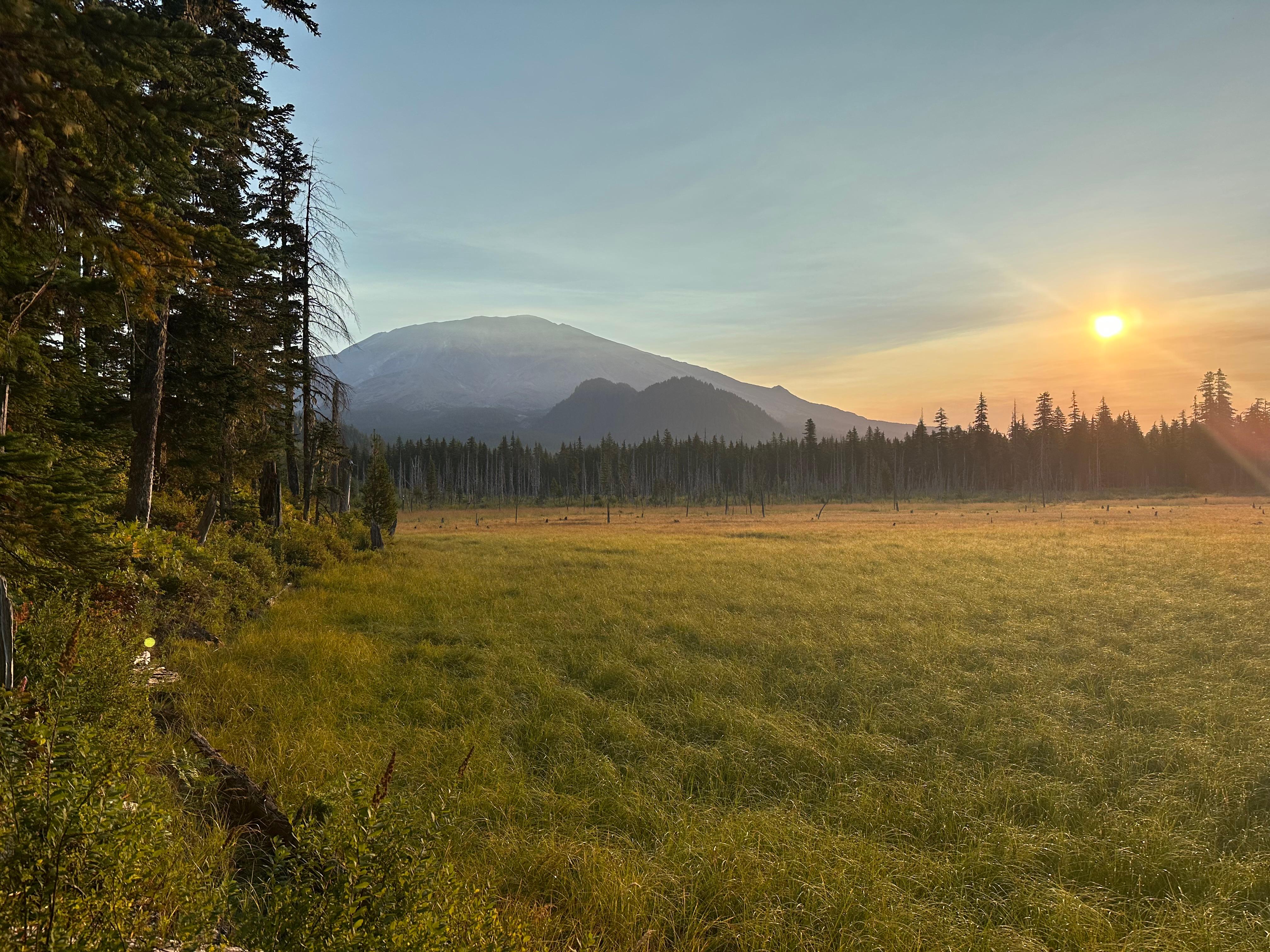 |
Climber's Bivouac | $5 Federal day use pass required. Also accepted: Annual Northwest Forest Pass or American the Beautiful Pass. Climbing above 4800' requires climbing permit. | Summer, fall: All hours. Winter, spring, early summer: Inaccessible by road. | Accessibility: No accommodations. Vault toilets. No water. Gravel road. Limited free tent sites available. Activities/Attractions: Summer Monitor Ridge climbing route access via Ptarmigan Trail. No mountain view from parking area. | 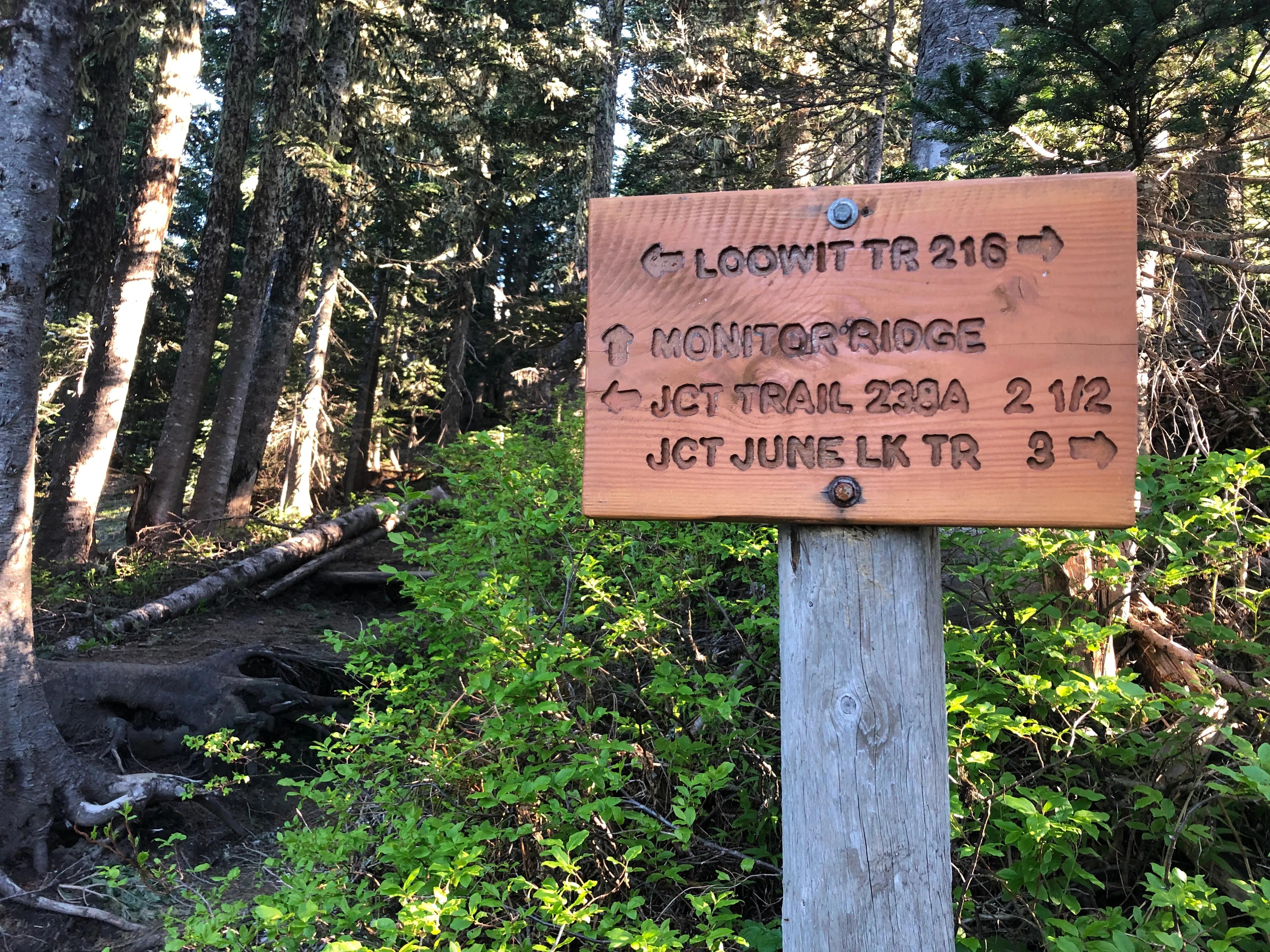 |
Marble Mountain Sno-Park | $5 Federal day use pass required. Also accepted: Annual Northwest Forest Pass or American the Beautiful Pass. Winter parking December 1 - March 31 requires Washington State Sno-Park Pass, available online. | All hours. | Accessibility: Paved parking lot. Vault toilets. No water. Gravel road. Activities/Attractions: Winter Worm Flows climbing route access, permit required. No mountain view from parking area. Winter motorized and non-motorized recreation. No recreational sledding available. | 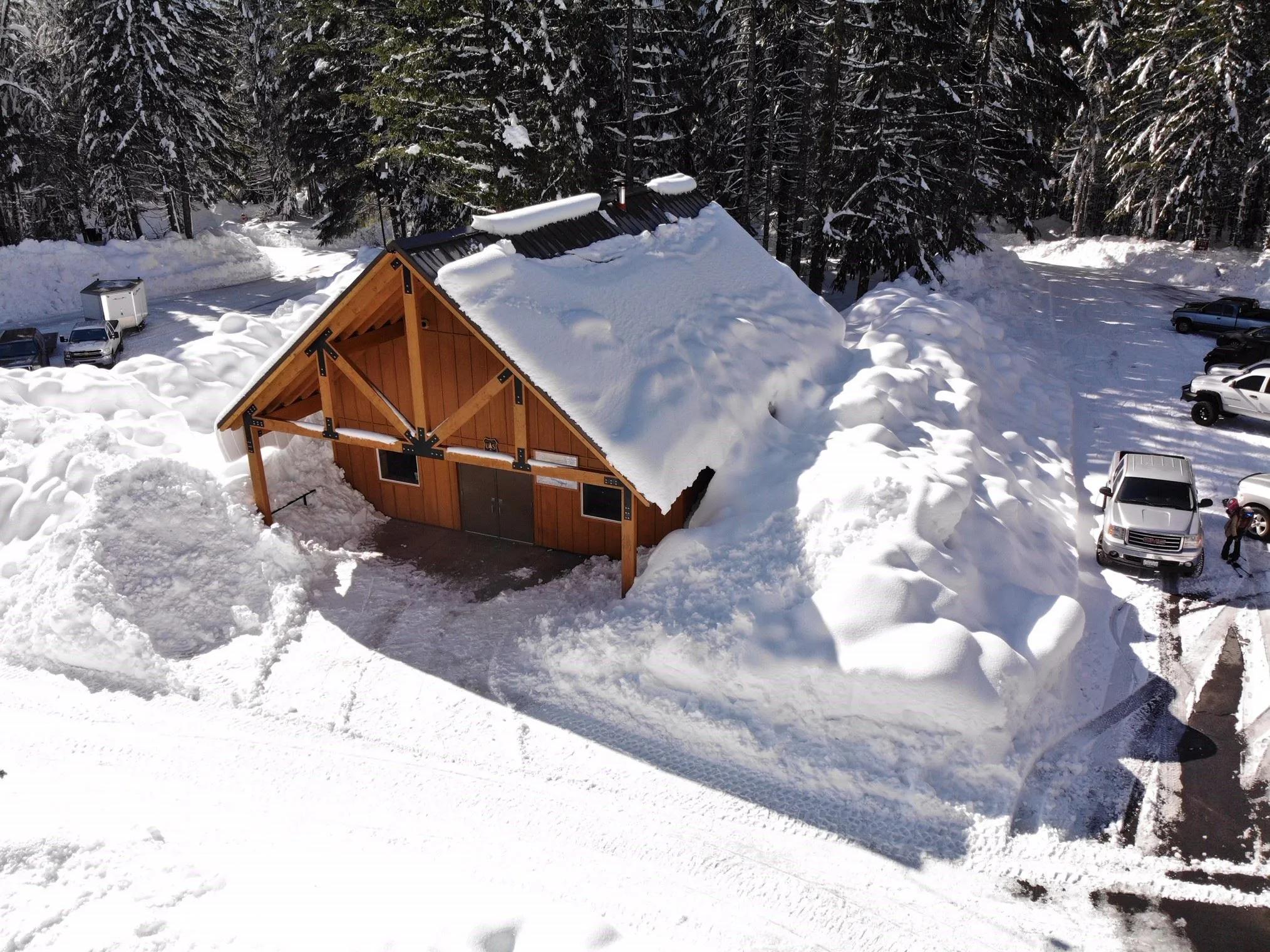 |
June Lake | No fee. | Summer, fall: Parking is day use only. Winter, spring, early summer: Inaccessible by road. | Accessibility: No toilets. No water. Gravel road. Limited parking. Uneven dirt trail. Activities/Attractions: Two mile hike to June Lake from parking lot. Access to Loowit Trail. Backpacking. Hiking. Camping is available at June Lake but there is no overnight parking in the June Lake parking lot. | 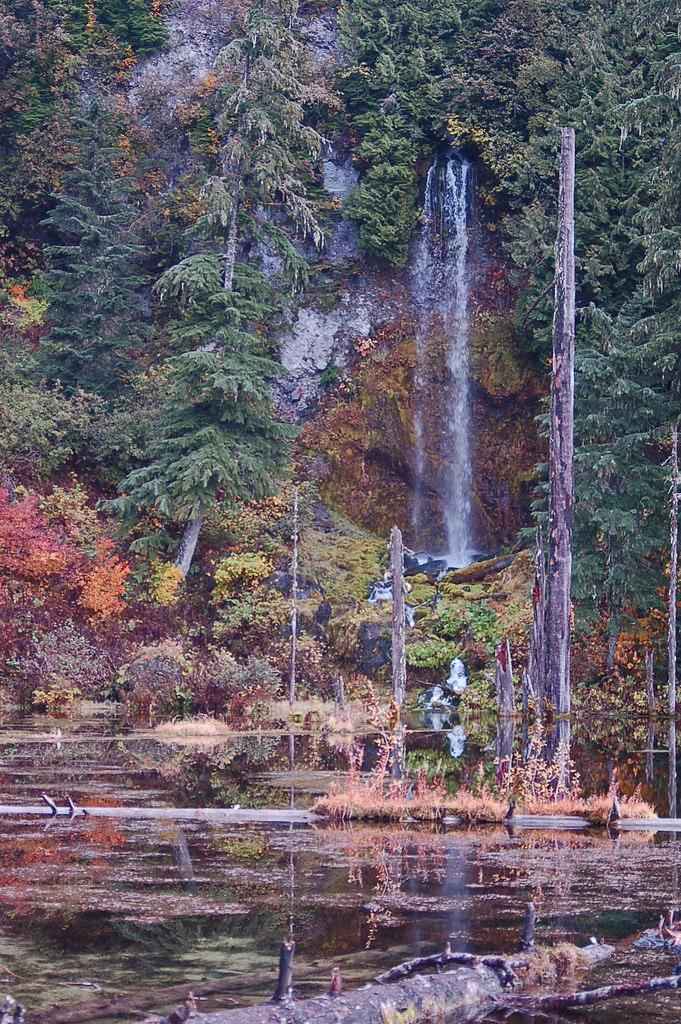 |
Lahar Viewpoint | No fee. | Summer, fall: All hours. Winter, spring, early summer: Inaccessible by road. | Accessibility: View of Mount St. Helens from parking area. Activities/Attractions: View of a lahar (mudflow) from the 1980 eruption. View of Mount St. Helens' south side (not the blast zone). |  |
Ape Canyon | Parking requires day or yearly pass. | Summer, fall: Day use only. Winter, spring, early summer: Inaccessible by road. | Accessibility: No accommodations. Vault toilets available at nearby Lava Canyon parking area. No water. Limited parking. Activities/Attractions: Hiking, mountain biking. |  |
Lava Canyon | $5 Federal day use pass required. Also accepted: Annual Northwest Forest Pass or American the Beautiful Pass. | Open June - October. Day use only. | Accessibility: Paved but very rough interpretive trail. Vault toilets. No water. Activities/Attractions: Picnic tables. Hiking. Dogs permitted on leash. Suspension bridge closed until further notice. Hiking. Turquoise blue river rushing through eroded canyon unveiled by 1980 eruption. | 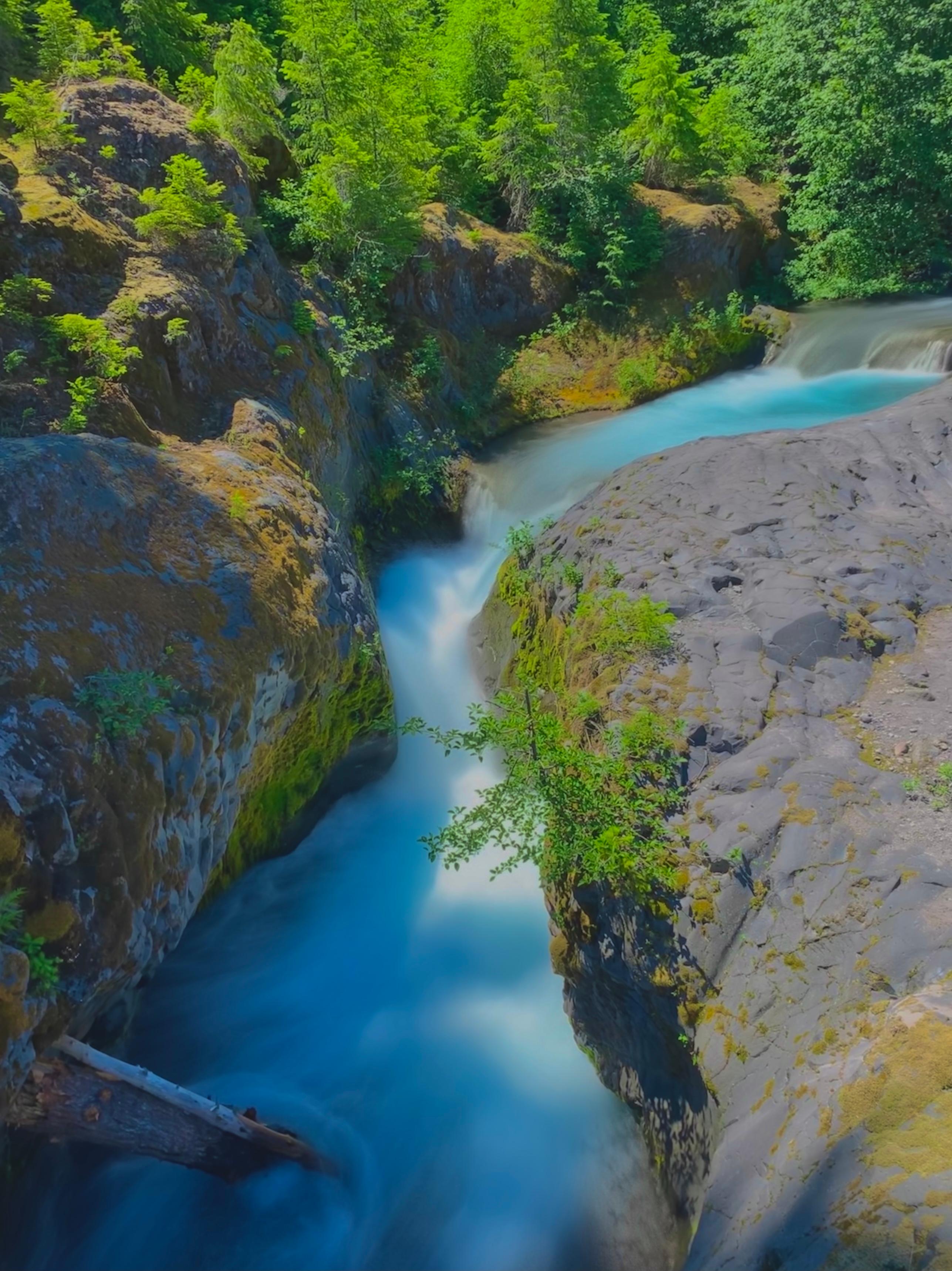 |
Other Area Activities
- Lewis River Falls (timed permit required)
- Outdoor recreation in the Gifford Pinchot National Forest
- Camping, boating, fishing and swimming at Lake Merwin, Yale Lake, Swift Reservoir, and Lake Merrill (Lake Merrill currently closed due to washout)
- Outdoor recreation in Yacolt Burn State Forest
- Shopping in Woodland and Battle Ground
Where to Stay
There are multiple campgrounds in Gifford Pinchot National Forest and around Cougar and Woodland.



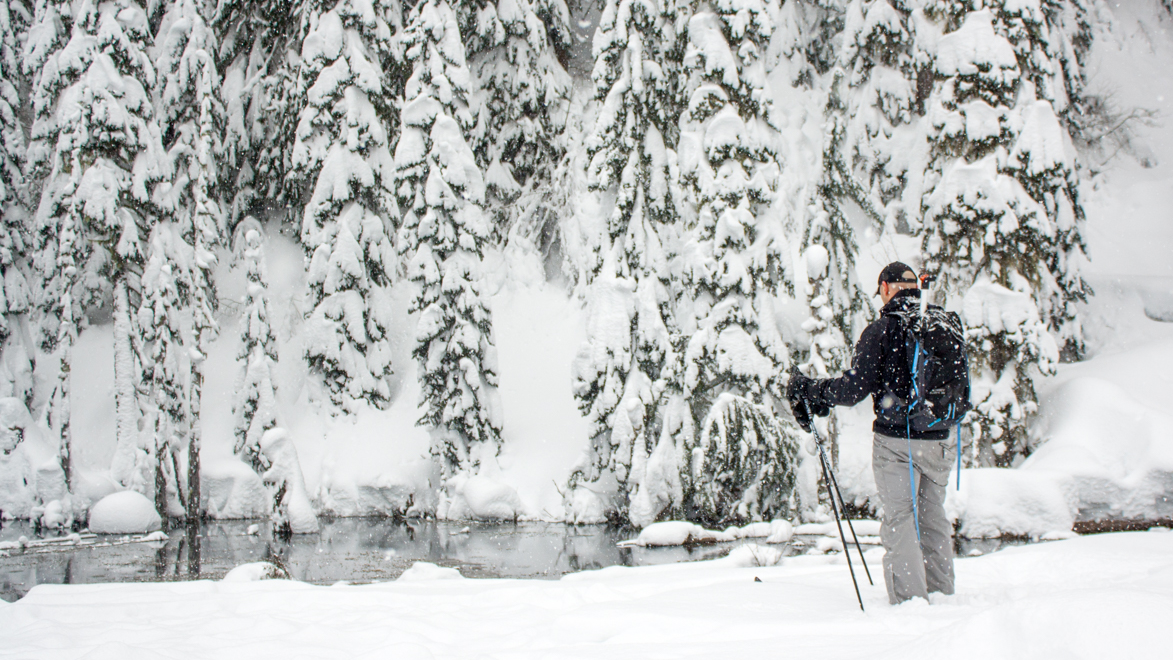
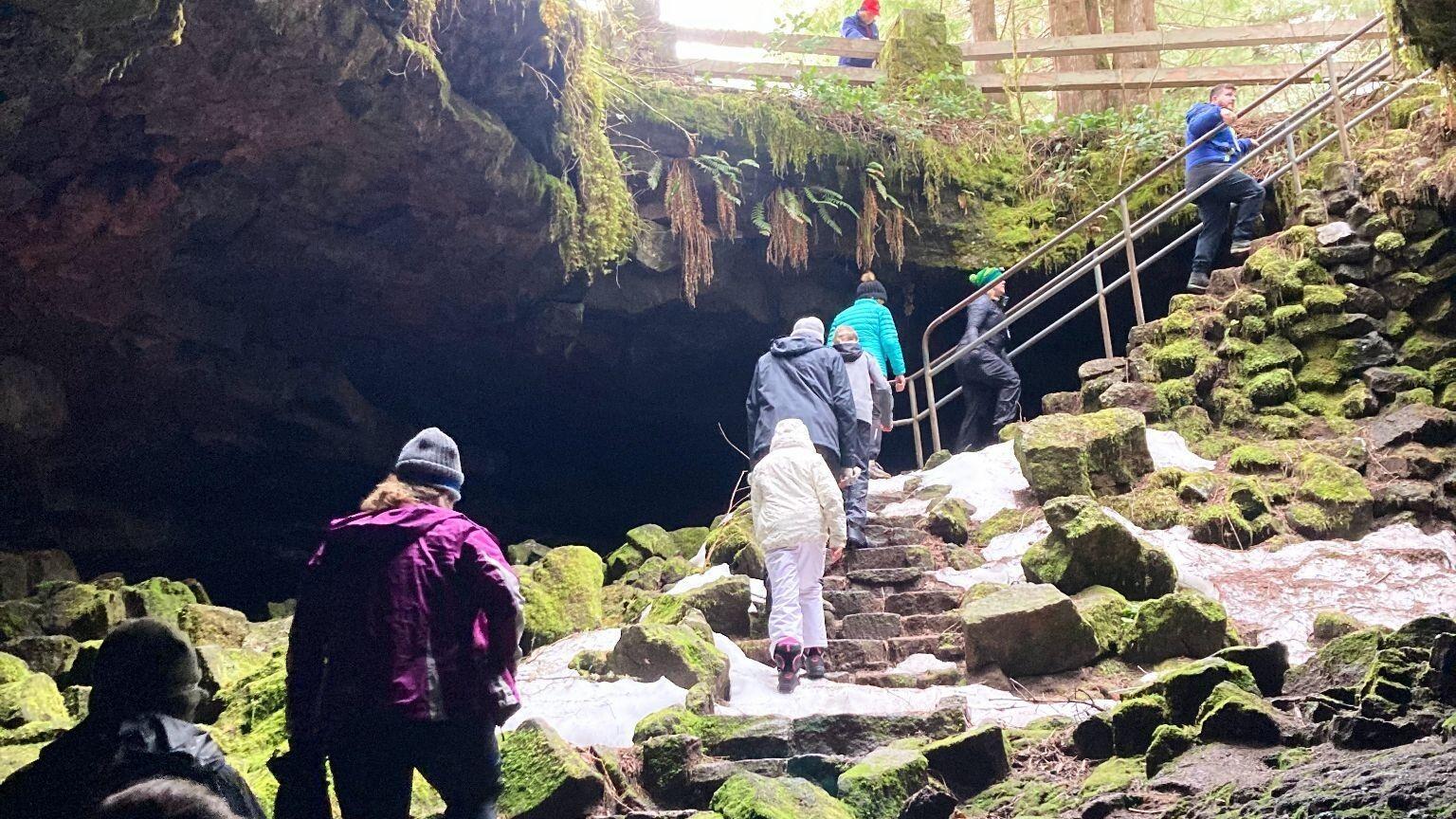



















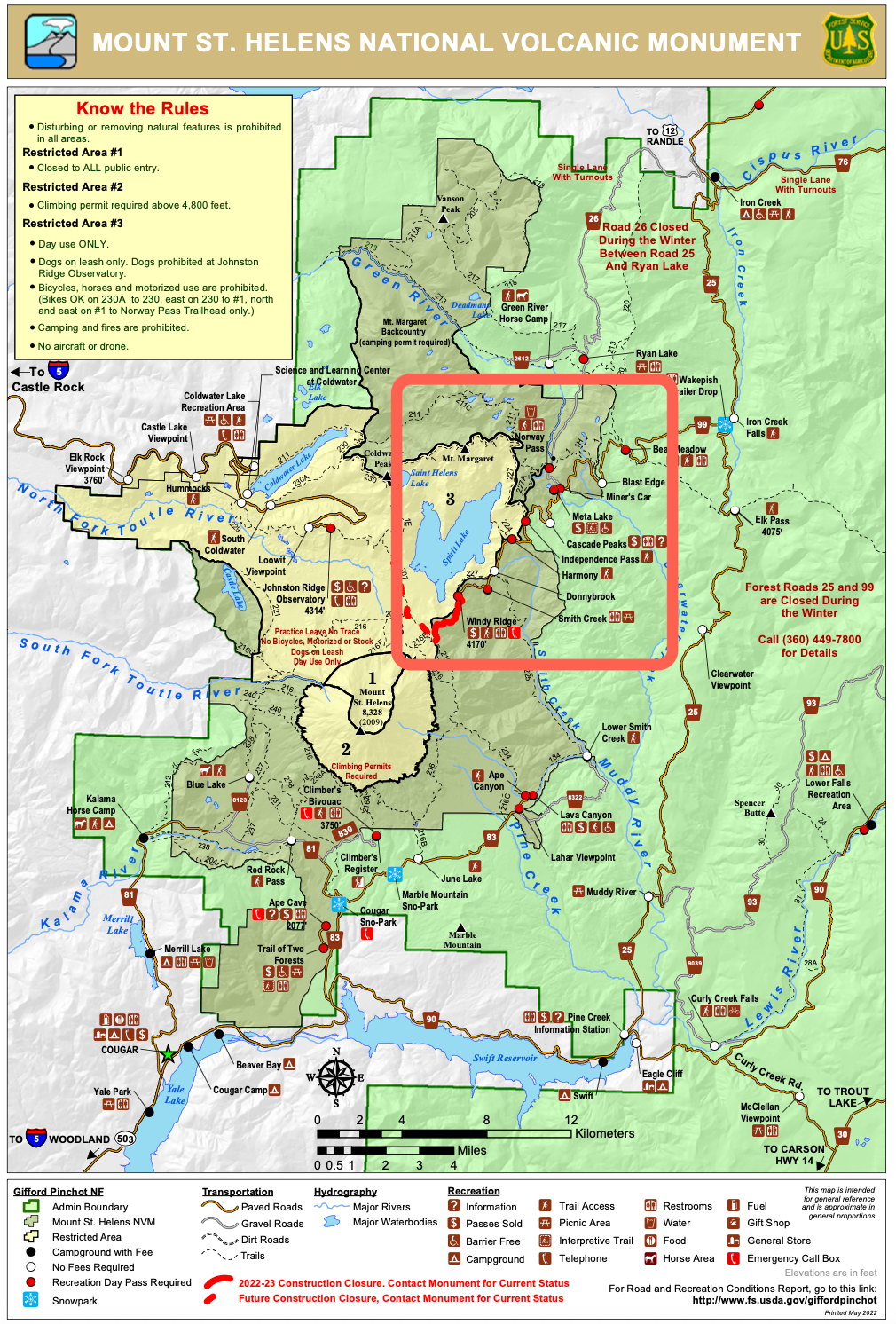
East Side: Blast Zone and Spirit Lake
Visit Mount St. Helens' east side to find solitude and experience Spirit Lake. Experience awe as you pass through zones of the eruption's destruction: standing dead trees, the blowdown forest, and arrive at the pumice plain. Access the magnificent Mount Margaret Backcountry.
East Side: Blast Zone and Solitude
The east side of Mount St. Helens features the most awe-inspiring experience of the blast zone. As one approaches Windy Ridge, the evidence of the impact of the 1980 eruption becomes clear as one passes through the standing dead trees and the blown down forest, eventually reaching the Pumice Plain, where 600 feet of material buried the previous forest floor.
Forest Road 99, the only road access to the area, is closed seasonally for snow. Access typically opens in late June or early July and closes mid-November.
September 2025: Forest 25, the main through-route on the east side, has reopened! After being closed since 2023, the road re-opened to the public September 18, 2025. Windy Ridge is now accessible from the south via Forest Road 25.
2025-2027: Hikes accessible from Windy Ridge include the Truman Trail, Loowit Trail, and the Abraham Trail. The Truman Trail is closed Monday through Friday due to Spirit Lake tunnel construction.
Mount St. Helens Institute Programs
North side programs include:
- Into The Crater Hike (overnight)
- Crater Glacier Overlook Hike
Mount St. Helens National Volcanic Monument Attractions
Attractions within the Monument on the north side have incredible views of the volcano and the Toutle River, which was dramatically affected by the 1980 eruption. Visit Coldwater Lake, which was created by the eruption! Attractions are listed from the closest to Mount St. Helens to the edge of the Monument.
Location | Fees | Hours/Season | Things to Do | |
|---|---|---|---|---|
Bear Meadows Interpretive Site | $5 Federal day use pass required. Also accepted: Annual Northwest Forest Pass or American the Beautiful Pass. | Typical season is early July through the end of October. Road closed for winter. Day use only. | Interpretive signage. Photo opportunities. Mountain and blast zone view. Picnic tables and restrooms. |  |
Miner's Car Interpretive Site | $5 Federal day use pass required. Also accepted: Annual Northwest Forest Pass or American the Beautiful Pass. | Typical season is early July through the end of October. Road closed for winter. Day use only. | Interpretive signage. Photo opportunities. | |
Meta Lake | $5 Federal day use pass required. Also accepted: Annual Northwest Forest Pass or American the Beautiful Pass. | Typical season is early July through the end of October. Road closed for winter. Day use only. | Interpretive signage. Photo opportunities. Lake view. Wheelchair accessible trail to lake's edge. | 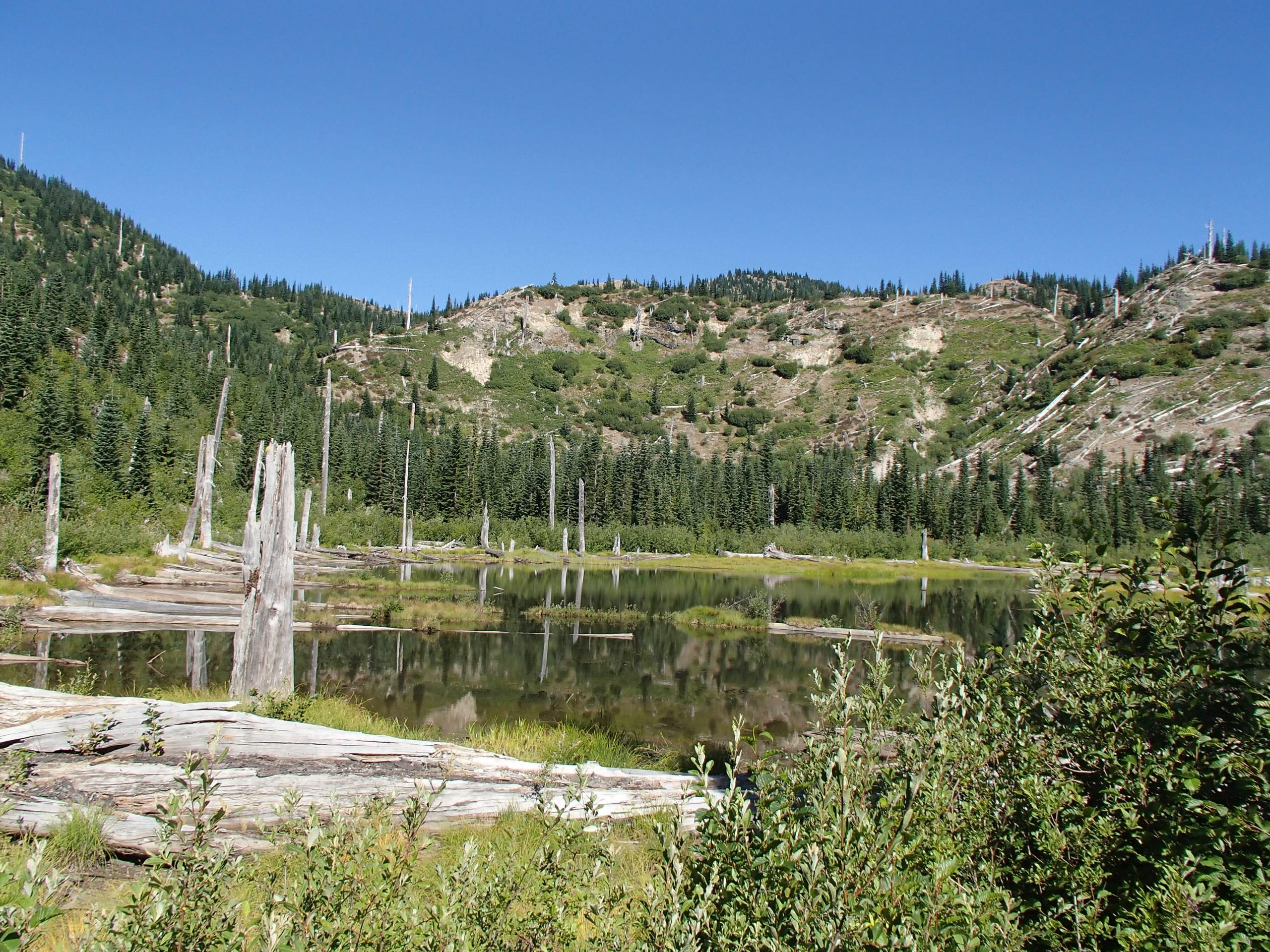 |
Cascade Peaks | $5 Federal day use pass required. Also accepted: Annual Northwest Forest Pass or American the Beautiful Pass. | Typical season is early July through the end of October. Road closed for winter. Day use only. | Interpretive signage. No food, drinks, or bathrooms. | |
Norway Pass | $5 Federal day use pass required. Also accepted: Annual Northwest Forest Pass or American the Beautiful Pass. | Typical season is early July through the end of October. Road closed for winter. Day use only. | Vault toilets. Access to Mount Margaret Backcountry (permit required for overnight camping). Hiking. Berries. Hike to mountain views. |  |
Harmony | $5 Federal day use pass required. Also accepted: Annual Northwest Forest Pass or American the Beautiful Pass. | Typical season is early July through the end of October. Road closed for winter. Day use only. | Interpretive signage. Photo opportunities. Lake and mountain views. Hiking to Spirit Lake. | 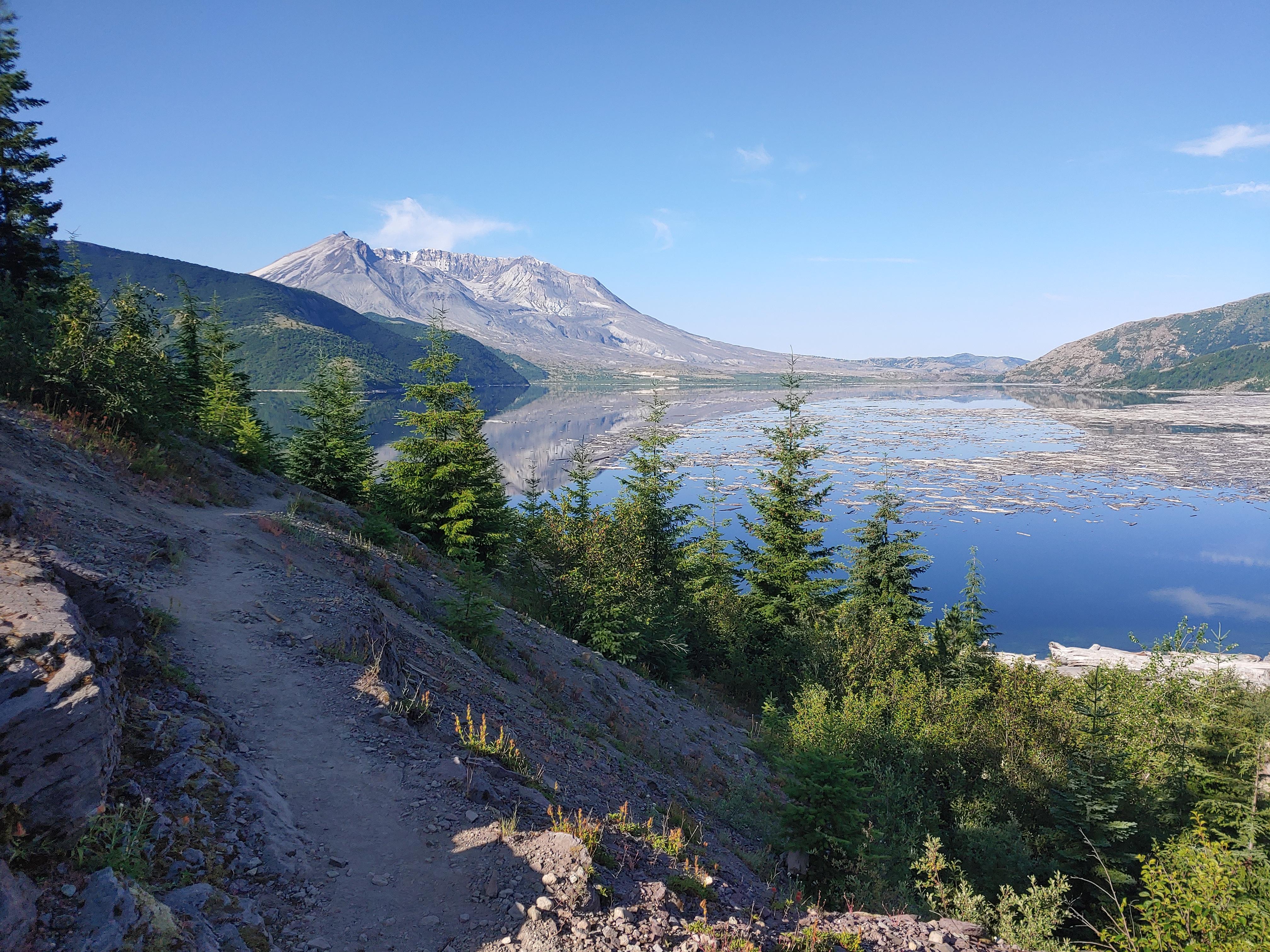 |
Windy Ridge | $5 Federal day use pass required. Also accepted: Annual Northwest Forest Pass or American the Beautiful Pass. | Typical season is early July through the end of October. Road closed for winter. Day use only. | Interpretive signage. Photo opportunities. Lake view. Wind-protected, accessible amphitheater with partial view. Trail access. Restrooms closed for repairs; nearest bathroom is at Smith Creek approximately 1 mile away. "Sand stairs" invite visitors to hike to a viewpoint above Windy Ridge parking area. | 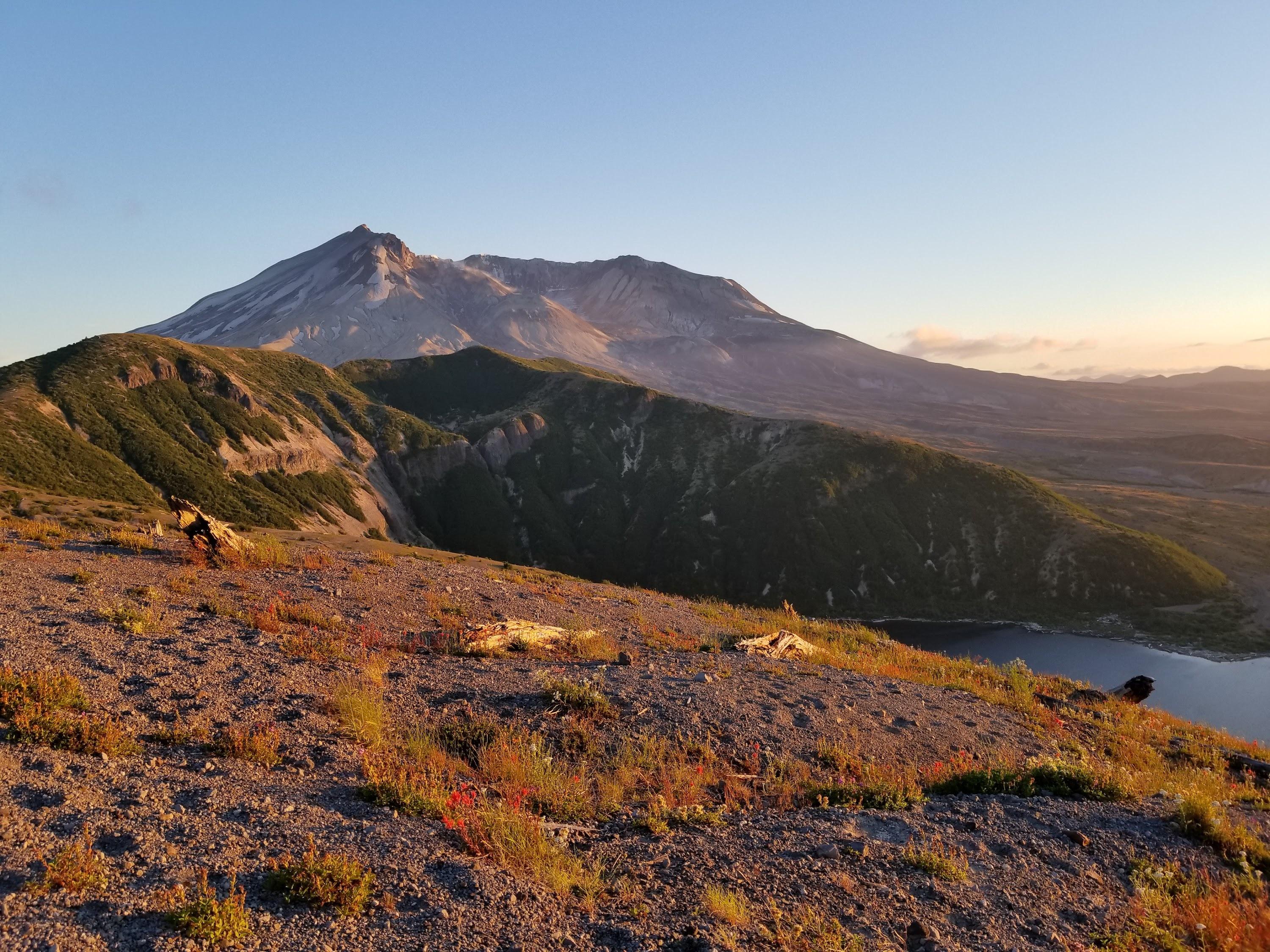 |
Area Activities
Highway 12 boasts access to Packwood and Randle, and other activities on the east side of the Gifford Pinchot.
Hiking, hunting, fishing, paddling, and mountain biking are popular activities in this area.
Directions
From the south: Forest Road 25 is now OPEN from the south.
From the north (Highway 12 / Randle): Visitors must take a detour from the north around the Huffaker Bridge closure. Download or print maps to navigate the closure.
Where to Stay
Morton, Packwood, and Randle offer a variety of accommodations. Campgrounds in the Gifford Pinchot are scattered throughout the area. The closest public campground to Windy Ridge is Iron Creek Campground in the Gifford Pinchot.
Mount St. Helens by the Season
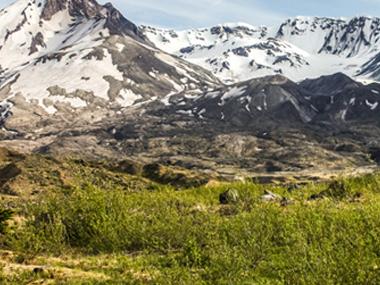



Spring at Mount St. Helens
Spring at Mount St. Helens offers limited options. Most major visitor attractions are closed - which means that the area is very quiet! If you like solitude but amazing views, spring is a great time to visit.
Best activities for spring
- Paddle at Coldwater Lake (wear warm clothes!)
- Summit Mount St. Helens (check out out our climb page for info on climbing in the snow). A spring climb uses the winter route, and permits are required.
- Hike to Johnston Ridge via the Hummocks and Boundary trails. These south facing trails are often snow-free while other trails are still buried.
- Snow begins to melt on trails at lower elevation, so check current conditions to see if trails require skis/snowshoes.
Amenities unavailable in spring
- Major visitor centers are generally closed until mid-May
- Roads to Windy Ridge, Climbers Bivouac, and Ape Cave are still closed for winter, with feet of snow lingering until late June or early July. Ape Cave generally opens in mid-May.
- Check weather reports before you go and be prepared for conditions of all types. Spring brings unpredictable weather!
Summer at Mount St. Helens
There is so much to do in the summer at Mount St. Helens! Wildflowers, waterfalls, hiking, visitor centers, it all happens in the summer. Check out Washington Trail Association's top picks at Mount St. Helens and Northwest Trail Alliance's mountain bike map.
Best activities for summer
Join Mount St. Helens Institute for a guided hike or campout!
North Side (Highway 504 corridor)
- Paddle or picnic at Coldwater Lake
- Hike the Hummocks or Lakes trail
- Stop by a visitor center:
- The Science and Learning Center at Coldwater
- The Mount St. Helens Visitor Center (Washington State Parks, Castle Rock)
South Side
- Summit Mount St. Helens (check out our climb page for info on climbing). Snow lingers through July; check weather reports before you go and prepare for unpredictable weather
- Descend into Ape Cave for an unforgettable experience (timed vehicle entry ticket required). Bring 2+ sources of lights and a jacket for the chilly cave
- Stop at the Lahar Viewpoint on your way to Lava Canyon, a gorgeous slot canyon uncovered by the 1980 eruption
- Hike the 32 mile Loowit trail that circumnavigates Mount St. Helens
East Side (Forest Road 99 from Randle)
- Count the 350+ steps as you climb to the viewpoint at Windy Ridge
- Visit scenic Meta Lake (wheelchair accessible)
- Backpack in the Mount Margaret backcountry (permits required for overnight stays)
- Hike to Loowit Falls
- Scariest summer hike: Whittier Ridge-Lakes Loop. Narrow trail with sheer drop-offs.
Air Quality
- Air quality in the Pacific Northwest may be impacted by fires in the region during fire season, August to October. Check local conditions before you go, and use judgment when recreating outdoors in poor air quality.
Activities to save for another season
- The hike from the Hummocks to Johnston Ridge Observatory is hot and exposed. Save this hike for a cloudy day.
Autumn at Mount St. Helens
Autumn at Mount St. Helens is prime time for mushrooms and fall colors! Avoid the summer crowds while enjoying beautiful sunny days in September and October.
Best activities for autumn
Join Mount St. Helens Institute for a guided mushroom forage!
North Side (Highway 504 corridor)
- Bask in the autumn sun on the deck of the Science and Learning Center
- Best fall color hike: South Coldwater Trail
South Side
- Munch on the last of the berries as you hike the Ape Canyon trail (commercial collecting prohibited)
- Forage for mushrooms in the forest
- Best fall color hike: June Lake
East Side (Forest Road 99 from Randle)
- Snack on huckleberries along the path to Norway Pass
- Hike down to Spirit Lake via the 1.2 mile (one way) Harmony Falls trail. Just remember you have to climb back up!
- Best fall color hike: Norway Pass
Activities to save for another season
- Water is scarce on the Loowit Trail until the rains begin again, but the autumn colors are beautiful! Carry plenty of water with you if you hike between late July and early October.
- If you're looking for wildflowers, most blooms are gone by September.
Winter at Mount St. Helens
Once the snow flies, many roads around the mountain are closed. Check current conditions before heading out. Be prepared for inclement and quickly changing weather. Highway 504 is regularly plowed; see current road conditions for details.
Best activities for winter
Join Mount St. Helens Institute for a winter snowshoe adventure!
Traction tires are recommended for winter travel. Carry tire chains, check conditions before you go, and be prepared for emergencies.
South Side
- Cross country ski, snowshoe, or snowmobile from the Cougar or Marble Mountain Sno-Parks; both require a Washington State Sno-Park permit; Marble Mountain provides the most parking. The area groomed trail map is available here. Motorized and non-motorized activities are available.
- The shelter at Marble Mountain is open daily for shared use. No overnight use and no winter reservations.
- Summit Mount St. Helens (check out out our climb page for info on climbing in the snow). Use the winter route; permits are required.
- Sunny weekends are often busy and parking fills up at Sno-Parks. Please follow parking signage and maps to accommodate all recreational users and maintain entrances, exits, and drive aisles. Carry chains for winter travel, and bring a shovel in case a plow comes through and blocks your car in its parking space.
- A non motorized winter recreation map is here. Novice winter recreators may want to try routes like:
- Marble Mountain to Chocolate Falls (out and back)
- Marble Mountain to June Lake via the Swift, Pika and June Lake trails
- Along Forest Road 83, yield to motorized vehicles and snowshoe off groomed ski tracks.
- There is no sledding/tubing hill at Marble Mountain.
- Sno-Park rules, rights-of-way, and guidelines are available here.
- Other area sno-parks are less popular; try Old Man Pass, Koshko, and McLellan Meadows for nonmotorized winter recreation in the Mount Adams Ranger District, Wakepish on the north side of Mount St. Helens, or other South Cascades Sno-Parks on the Washington State Parks website.
North Side (Highway 504 corridor)
- Snowshoe or cross country ski at the hummocks (Hummocks trail not marked for the winter)
- Highway 504 is plowed daily unless plows are needed down-mountain. Carry chains for winter travel.
- Visitor centers, including Washington State Parks' Mount St. Helens Visitor Center in Silver Lake and the USFS Science and Learning Center, have reduced operations for winter. Check their websites for current information.
- With appropriate gear and preparation (and decent weather!), winter kayaking at Coldwater Lake can be a peaceful, serene experience. Accessibility to the boat launch may be impacted by snow.
Activities to save for another season
- Highway 99 and access to Windy Ridge is closed for the winter.
- Weather can be amazingly clear or very cloudy and foggy. Views of the mountain are less likely because the weather tends to be cloudy, but when it clears, the views during winter are stunning.
- The Weyerhaeuser Forest Learning Center is closed during the winter.
- Ape Cave closes for the winter.
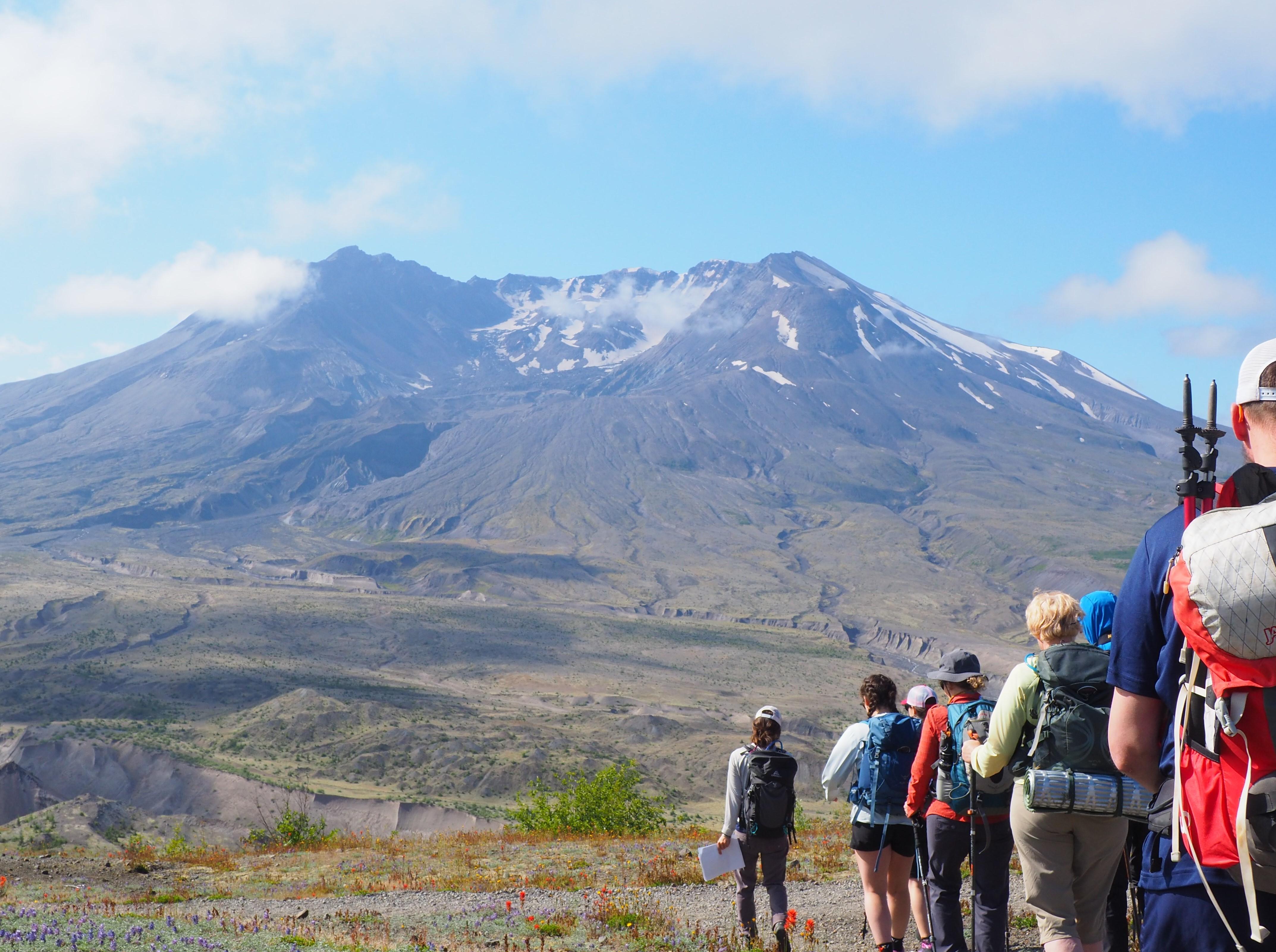
Other Ways to Visit
Mount St. Helens Institute offers a variety of day and overnight programs at the volcano:
- Field Trips for schools, home schools, and families
- Guided Hikes and Adventures
- Campouts
